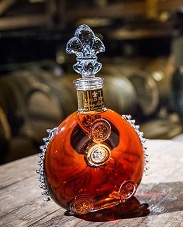
In the world of fine wine and spirits the sophisticated flavors of cognac and wine stand as two quintessential choices, each with its unique allure. While they may share a common foundation in fermented grapes, their production methods, flavor profiles, and ideal pairings diverge dramatically, offering connoisseurs a rich tapestry of tastes to explore. Cognac, with its bold, smooth complexity, is often reserved for moments of indulgence, whereas wine, ranging from crisp whites to robust reds, can easily accompany any occasion. As we attempt to discover the subtle yet substantial differences between cognac and wine, we’ll dive into their distinct characteristics, the art of pairing them with food, and how to elevate your tasting experience. Whether you’re a seasoned enthusiast or a curious newcomer, understanding these differences will enhance your appreciation for both beverages, guiding you toward the perfect pairing that will delight your palate. Better yet explore the region in person with our Private Cognac wine tours.
Cognac and wine, though both originating from grapes, embark on distinct journeys from vineyard to glass. Their differences start at the very root—the type of grapes used. For cognac, the primary grape is Ugni Blanc, known for its high acidity and low alcohol content, which are ideal for distillation. Wine, on the other hand, boasts a diverse range of grape varieties, each imparting unique flavors and characteristics to the final product. The terroir, or the environment where the grapes are grown, also plays a significant role, influencing the taste profiles of both cognac and wine.
The production processes for cognac and wine diverge significantly after the grape harvest. Cognac undergoes a meticulous double-distillation process in copper pot stills, known as Charentais stills, followed by aging in oak barrels for at least two years. This process imparts complex flavors and aromas, transforming the spirit into the rich, amber liquid we recognize as cognac. Wine production, conversely, involves crushing the grapes to release their juice, which is then fermented, either with or without the grape skins, to produce the desired wine style. The aging process for wine varies greatly, depending on the type of wine and the winemaker's preferences.
Flavor profiles are another area where cognac and wine part ways. Cognac is renowned for its depth and complexity, with notes ranging from fruity and floral to spicy and nutty, often accompanied by a smooth, velvety texture. Wine, however, offers a vast spectrum of flavors, from the crisp acidity of a Sauvignon Blanc to the bold, tannic structure of a Cabernet Sauvignon. This variety allows wine to pair seamlessly with a wide range of foods, enhancing the dining experience. Cognac, though versatile, is often enjoyed on its own or with select food pairings that complement its rich, layered profile.

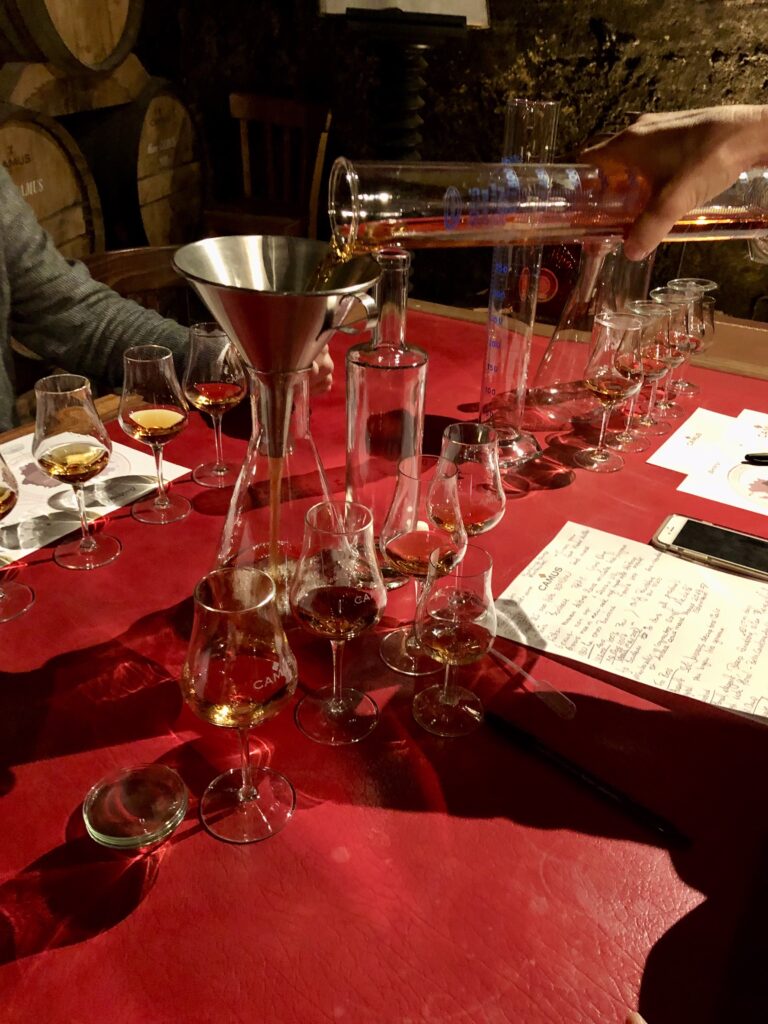
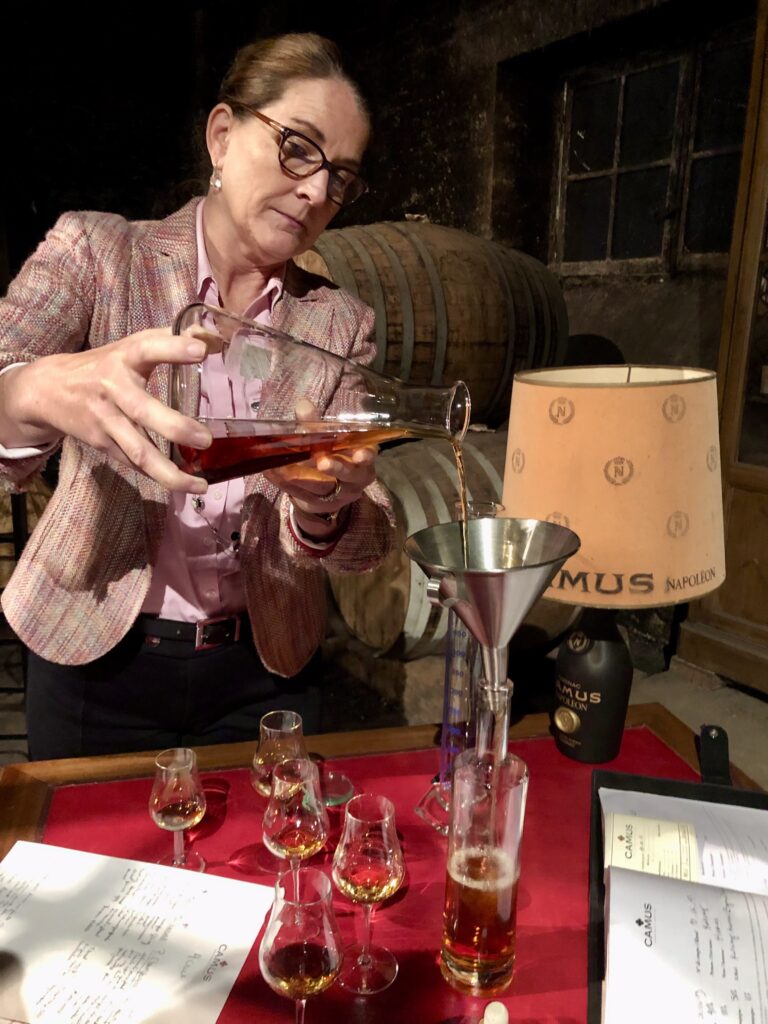
The production of cognac is a labor-intensive, artisanal process that begins in the vineyards of the Cognac region in France. The primary grape used for cognac is Ugni Blanc, prized for its high acidity, which is essential for the distillation process. These grapes are harvested, pressed, and fermented into a low-alcohol wine, typically around 7-9% ABV (alcohol by volume). This wine serves as the base for the distillation process, which is where the transformation into cognac truly begins.
Distillation is the heart of cognac production and is conducted in traditional copper pot stills known as Charentais stills. This process involves two distinct distillations. The first distillation, or "première chauffe," produces a liquid called "brouillis," which is then distilled a second time in the "bonne chauffe." This second distillation yields the "eau-de-vie," or "water of life," with an alcohol content of about 70%. This clear, potent liquid is then ready for aging.
Aging is a crucial step that imparts cognac with its rich flavors and amber color. The eau-de-vie is aged in French oak barrels, which contribute to the spirit's complexity. The aging process must last at least two years, but many cognacs age for much longer, with some of the finest cognacs maturing for decades. During this time, the liquid interacts with the wood, developing notes of vanilla, spice, and dried fruit, all while losing some alcohol content and gaining a smoother texture. The final step involves blending different aged eaux-de-vie to achieve the desired flavor profile, a task that requires a master blender's expertise. See each of these steps or experience it yourself on our Cognac Tasting tour.
Wine production is a diverse and intricate process, with each step influencing the final product's flavor and style. The journey begins in the vineyard, where the choice of grape variety, soil composition, climate, and vineyard management practices all play pivotal roles. Grapes used for winemaking come in a wide array of varieties, each bringing its unique characteristics to the wine. For instance, Chardonnay grapes produce wines with rich, buttery textures, while Pinot Noir grapes yield lighter, more delicate wines.
Once the grapes are harvested—either by hand or machine—they are sorted, crushed, and pressed to extract the juice. For white wine, the juice is quickly separated from the grape skins to maintain a lighter color and flavor. For red wine, the juice is fermented with the skins, which imparts color, tannins, and additional flavors. Fermentation is a critical stage where yeast converts the sugars in the grape juice into alcohol, producing the primary wine. Temperature control during fermentation is essential, as it influences the wine's flavor development.
After fermentation, the wine may undergo various processes such as malolactic fermentation, which softens the acidity, or aging in oak barrels, which can add complexity and depth. The wines are then clarified, filtered, and bottled. The aging potential of wine varies; some wines are best enjoyed young, while others benefit from extended aging, developing more nuanced flavors over time. This diversity in production techniques and grape varieties results in the broad spectrum of wine styles, from light and crisp whites to bold and tannic reds, each offering unique tasting experiences.
Cognac and wine hold a revered place in French culture, symbolizing the country's rich heritage and artisanal craftsmanship. France is renowned worldwide for its wine regions, such as Bordeaux, Burgundy, and Champagne, each producing wines with distinct characteristics and immense prestige. Wine is deeply intertwined with French cuisine, often considered an essential component of a meal. The practice of pairing wine with food is a cherished tradition, enhancing the flavors of both the wine and the dish, and reflecting the French philosophy of savoring every culinary experience.
Cognac, produced exclusively in the Cognac region, is another jewel in France's crown of fine beverages. The meticulous production process and long aging periods required to create high-quality cognac exemplify the dedication to excellence that French artisans are known for. Cognac's association with luxury and sophistication has made it a symbol of French elegance, often enjoyed in settings that celebrate refinement and indulgence. Its cultural significance is also evident in literature and art, where cognac frequently appears as a motif of opulence and tradition.

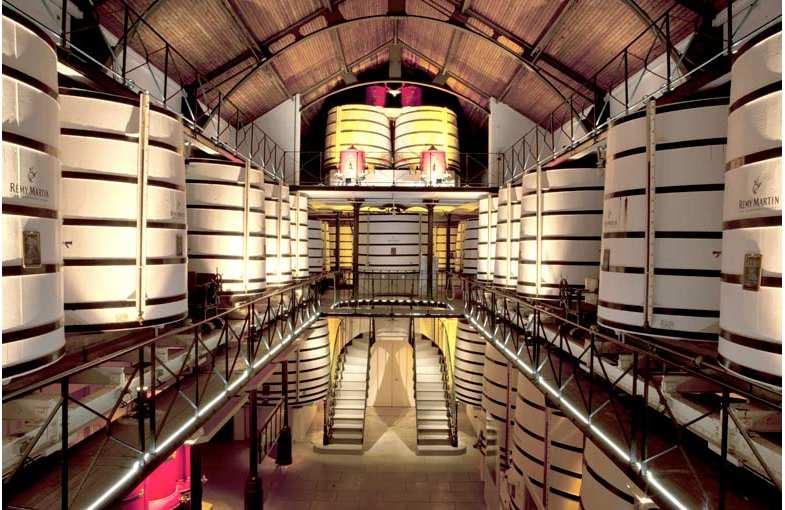
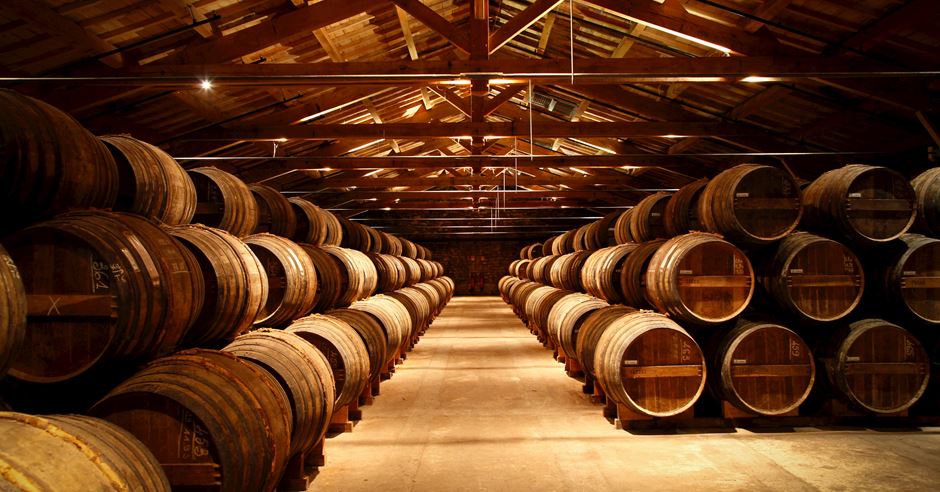

France's reputation for exceptional spirits and wines stems from its diverse regional terroirs. When it comes to Cognac, the production is concentrated in a specific region in south western France, while wine production spans several distinctive areas across the country.
The Cognac region, situated just north of Bordeaux along the Charente River, is divided into six crus: Grande Champagne, Petite Champagne, Borderies, Fins Bois, Bons Bois, and Bois Ordinaires. Grande Champagne produces the most prestigious Cognacs, known for their exceptional aging potential and refined floral aromas.
For wine, Bordeaux stands as France's largest quality wine region, renowned for its exceptional red blends featuring Cabernet Sauvignon and Merlot. Burgundy, with its limestone-rich soils, produces some of the world's most coveted Pinot Noir and Chardonnay wines. Champagne, in northeastern France, creates the world's most celebrated sparkling wines through its unique méthode champenoise.
Other significant wine regions include the Rhône Valley, known for Syrah-based reds and Viognier whites; Loire Valley, celebrated for its diverse styles from Sancerre to Vouvray; and Alsace, producing distinctive aromatic white wines influenced by German traditions.
These regions' distinct terroirs, (climates, soils, and centuries-old traditions) continue to shape France's unparalleled reputation in the global beverage industry.
It explains how Cognac's rich, complex flavors work well with dishes like foie gras, cheeses, or desserts, while wine offers versatility with meals, pairing perfectly with everything from meats to seafood.
Cognac's rich complexity and nuanced flavor profile make it an exceptional pairing companion for various foods, particularly after dinner as a digestif.
Cheeses: Cognac pairs wonderfully with bold, aged cheeses. Try it with Roquefort, where the spirit's sweet notes balance the cheese's salty intensity. Aged Comté and Mimolette, with their nutty characteristics, also create harmonious pairings with VSOP or XO Cognacs.
Chocolate & Desserts: Dark chocolate with 70% or higher cocoa content creates a sublime marriage with Cognac, particularly aged expressions. The spirit's vanilla and caramel notes complement rich desserts like crème brûlée, tarte tatin, or chocolate fondant. For a simpler pairing, try fresh figs or dried apricots with a younger VS Cognac.
Savory Delicacies: Foie gras pairs exceptionally well with Cognac, as the spirit cuts through the richness while complementing its buttery texture. Duck confit or pâté also shine alongside a glass of fine Cognac.
While wine offers tremendous versatility throughout a meal—from light whites with seafood to robust reds with beef—Cognac typically shines most brightly at the end of dining experiences. Wine adapts to the main course, whether it's a crisp Sancerre with oysters or a bold Bordeaux with lamb, while Cognac elevates the conclusion of a memorable meal.
The distinction in pairing approaches highlights the complementary relationship between these two French treasures—wine accompanies the journey, while Cognac provides the perfect finale.
Tasting Cognac and wine side-by-side tasting offers a fascinating exploration of France's finest beverages, highlighting their contrasting production methods, flavor profiles, and sensory experiences.
Consider this approach to tasting or serving wine and cognac:
Start with lighter wines such as Champagne or white Burgundy before progressing to more robust reds like Bordeaux or Rhône Valley selections. This prepares your palate for the intensity of Cognac, which should conclude the tasting sequence.
For Cognac, progressing from VS to VSOP to XO helps to experience the evolution of complexity through aging.
Temperature matters significantly—serve wines at their optimal temperatures (chilled whites, room temperature reds) and Cognac slightly below room temperature in tulip-shaped glasses that concentrate aromas.
When tasting Cognac and wine, training your palate to identify specific flavor components enhances appreciation of their distinct characteristics.
In Cognac, look for a progression of flavor notes that evolve with age:
The tasting technique for Cognac involves examining its color against light, swirling to release aromas, and taking small sips to coat the entire palate.
For wine, flavor profiles vary dramatically by grape variety and region:
When tasting wine, evaluate its color, clarity, aroma intensity, specific flavor notes, body, acidity, tannin (for reds), and finish length.
The contrast between wine's fermented grape expression and Cognac's distilled concentration creates a fascinating study in transformation—wine preserves grape character while Cognac concentrates and transforms it through distillation and barrel aging.
Discover the ultimate French wine and Cognac experience with Decanter Tours' expertly curated journeys through France's most prestigious wine regions.
Our exclusive Bordeaux-Cognac Connection tour offers the perfect introduction to both worlds, beginning in the celebrated vineyards of Bordeaux before venturing to the historic Cognac houses along the Charente River. Led by certified sommeliers and spirits experts, these intimate tours provide unprecedented access to family-owned estates and prestigious houses not typically open to the public.
Experience the complete journey from the vineyard to the bottle as you witness wine fermentation techniques in Bordeaux's grand châteaux, then observe the traditional double-distillation methods in Cognac's copper pot stills. Our expert guides will teach you professional tasting techniques applicable to both beverages, enhancing your appreciation for life.
Accommodations feature boutique luxury hotels in historic properties, while dining experiences showcase regional cuisine perfectly paired with the wines and Cognacs you'll discover throughout your journey.
Whether you're a serious collector or simply passionate about French wine, Decanter Tours offers customizable itineraries that can be tailored to your specific interests—from historic Grande Champagne houses to innovative new producers pushing boundaries in all French wine regions.
Book your immersive tasting journey today and discover why these iconic French wines have captivated connoisseurs for centuries. Limited spaces available for our signature summer tours—reserve your experience now through our website or contact our concierge team for bespoke private tour options.
Contact us to learn more.
Cognac and wine differ fundamentally in their production methods, alcohol content, and flavor profiles. Wine is made through the fermentation of grape juice, resulting in an alcoholic beverage typically ranging from 11-15% ABV. Cognac, however, begins as wine but undergoes double distillation in copper pot stills and extensive oak aging, resulting in a spirit with 40% ABV or higher.
The production regions also differ significantly. While wine is produced worldwide, true Cognac can only come from the designated Cognac region in western France. Additionally, Cognac must be made from specific grape varieties, primarily Ugni Blanc.
In terms of consumption, wine is typically enjoyed with meals and comes in numerous varieties and styles. Cognac is traditionally served as a digestif after dining, with its complex flavor profile categorized by age designations (VS, VSOP, XO) rather than by grape variety.
While Cognac begins its life as wine, it is not classified as a wine but rather as a brandy or spirit. All Cognac starts as a relatively acidic, low-alcohol white wine produced primarily from Ugni Blanc grapes. This wine serves as the base for distillation, where it undergoes a transformative process.
The distillation process concentrates the alcohol and certain flavor compounds from the wine, creating what is called eau-de-vie. This clear spirit then ages in French oak barrels, developing color and complexity over time. Through this production journey, the wine base is fundamentally transformed, removing Cognac from the wine category and placing it firmly in the spirits category.
Therefore, while Cognac shares a grape origin with wine, it belongs to the brandy family of spirits rather than the wine family.
Wine and Cognac serve different roles in the dining experience and pair with foods in complementary ways:
Wine Pairings:
Cognac Pairings:
For the best dining experience, consider serving wine during the meal based on the main course, then transitioning to Cognac after dinner with dessert or cheese. This progression allows both beverages to showcase their strengths without competing with each other.
Absolutely! A side-by-side tasting of Cognac and wine offers an educational and enjoyable experience that highlights the relationship between these two French specialties. When organizing such a tasting, consider these recommendations:
A comparative tasting allows participants to appreciate the fundamental differences in production methods, flavor development, and sensory characteristics while understanding how both beverages represent the pinnacle of French beverage craftsmanship.
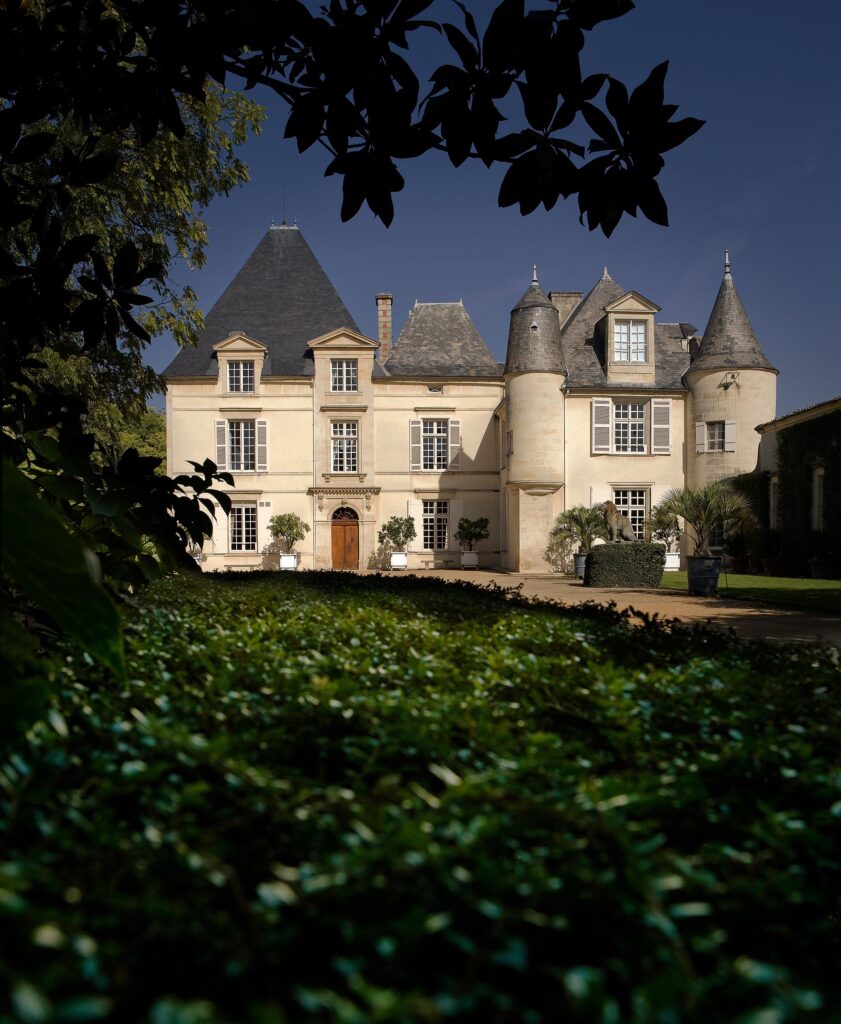
In the world of fine wines, few classifications hold the prestige and historical significance of the Grand Cru Classé de Graves. This elite designation represents the pinnacle of winemaking excellence in Bordeaux's Graves region, encompassing 16 exceptional châteaux renowned for their outstanding terroir and winemaking traditions. Whether you're a seasoned wine connoisseur or an enthusiastic beginner, understanding this classification unlocks a deeper appreciation for some of Bordeaux's most distinguished wines.
The Grand Cru Classé de Graves represents an exclusive classification system that recognizes the most prestigious wine estates within the Graves region of Bordeaux. Unlike other Bordeaux classifications that focus solely on red or white wines, the Grand Cru Classé de Graves stands unique in acknowledging excellence in both varieties from the same estates.
This classification serves as a mark of exceptional quality, rigorous production standards, and consistent excellence. For wine enthusiasts, the Grand Cru Classé designation signals wines of remarkable character, complexity, and aging potential that embody the distinctive gravelly terroir from which they derive their name.
The classification's origins trace back to 1953 when it was first established, then subsequently revised in 1959 to its current form. This makes it considerably younger than the famous 1855 Bordeaux Classification that governs Médoc and Sauternes. While the 1855 classification resulted from Napoleon III's request for a ranking system for the Paris Exhibition, the Grand Cru Classé de Graves emerged from regional efforts to distinguish the exceptional estates within this historically significant winemaking area.
What sets this classification apart is its foundation in the post-World War II era, allowing it to incorporate more modern winemaking philosophies while still honoring traditional methods. The classification has remained unchanged since 1959, creating a stable legacy that continues to influence Bordeaux's wine industry today.
Achieving Grand Cru Classé de Graves status requires meeting exacting standards across multiple dimensions:
These stringent requirements ensure that only truly exceptional estates earn and maintain this prestigious classification, creating an assurance of quality for wine consumers worldwide.
The Grand Cru Classé de Graves classification encompasses exactly 16 châteaux, making it one of the most exclusive wine designations in the world. This limited membership underscores the exceptional quality required for inclusion and highlights the rarity of these distinguished wines.
What makes this classification particularly unique in Bordeaux is its recognition of both red and white wines from the same estates. While some châteaux excel primarily in one category, many produce outstanding examples of both, showcasing the versatility and excellence of the Graves terroir.
The Grand Cru Classé de Graves stands as the only Bordeaux classification that formally recognizes excellence in both red and white wine production. This dual categorization reflects the region's exceptional ability to produce world-class wines across different styles:
Red Wines: All 16 classified châteaux produce red wines, typically blends dominated by Cabernet Sauvignon and Merlot, with smaller proportions of Cabernet Franc and Petit Verdot. These reds are known for their structure, elegance, and remarkable aging potential.
White Wines: Several of the classified châteaux also produce exceptional white wines, primarily from Sauvignon Blanc and Sémillon grapes. These whites are celebrated for their complexity, mineral character, and ability to develop beautifully with age – a characteristic that sets them apart from many white wines worldwide.
This dual classification system highlights the Graves region's unique diversity and versatility in winemaking, offering enthusiasts a comprehensive experience of Bordeaux's finest expressions. However there are no individual rankings (first, second, third classified growth etc.) like for the 1855 classification of the Graves and Sauternes.
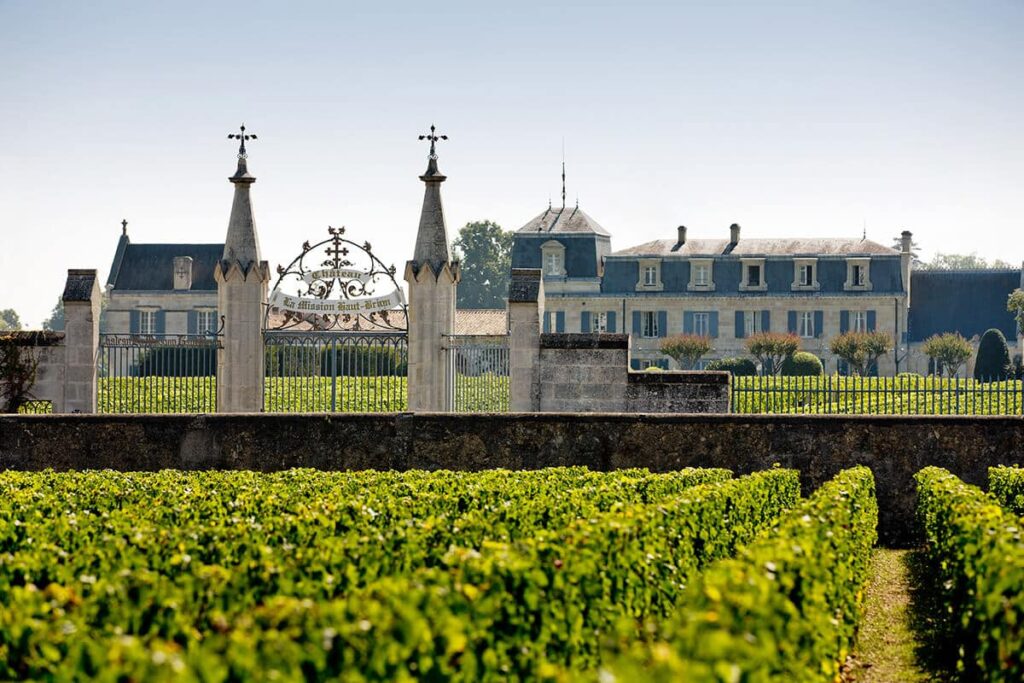
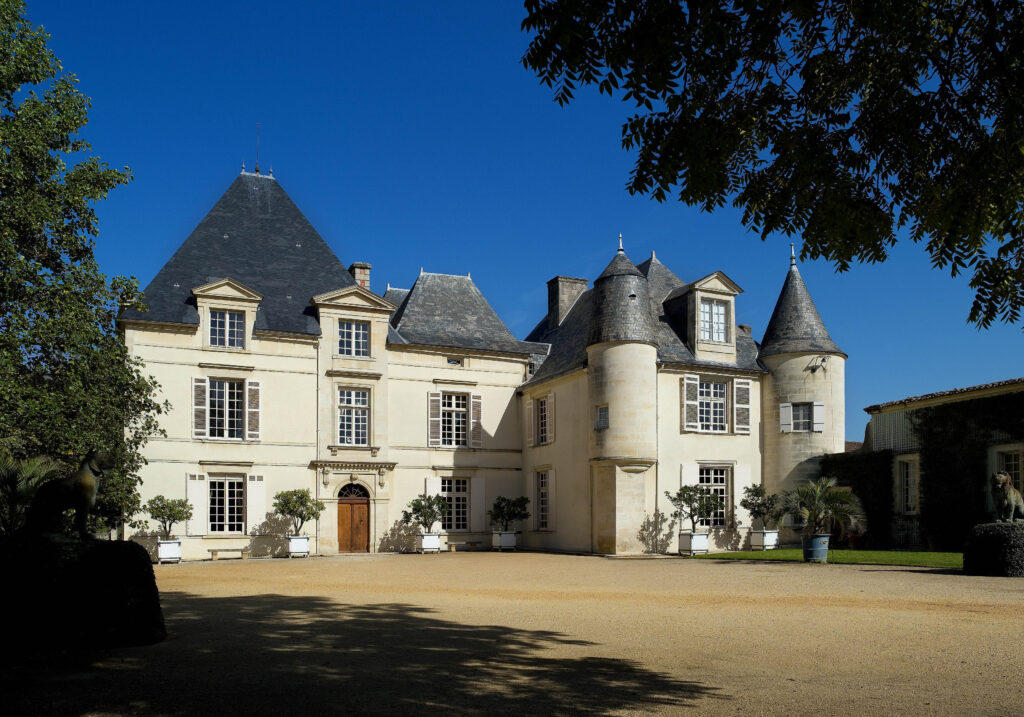
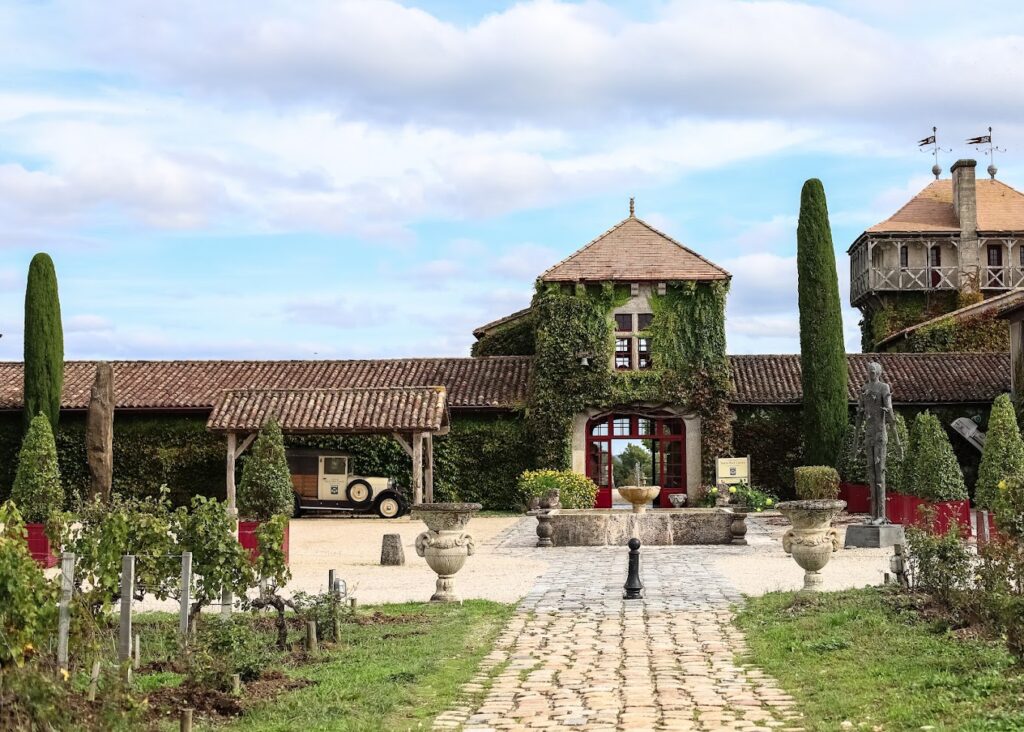
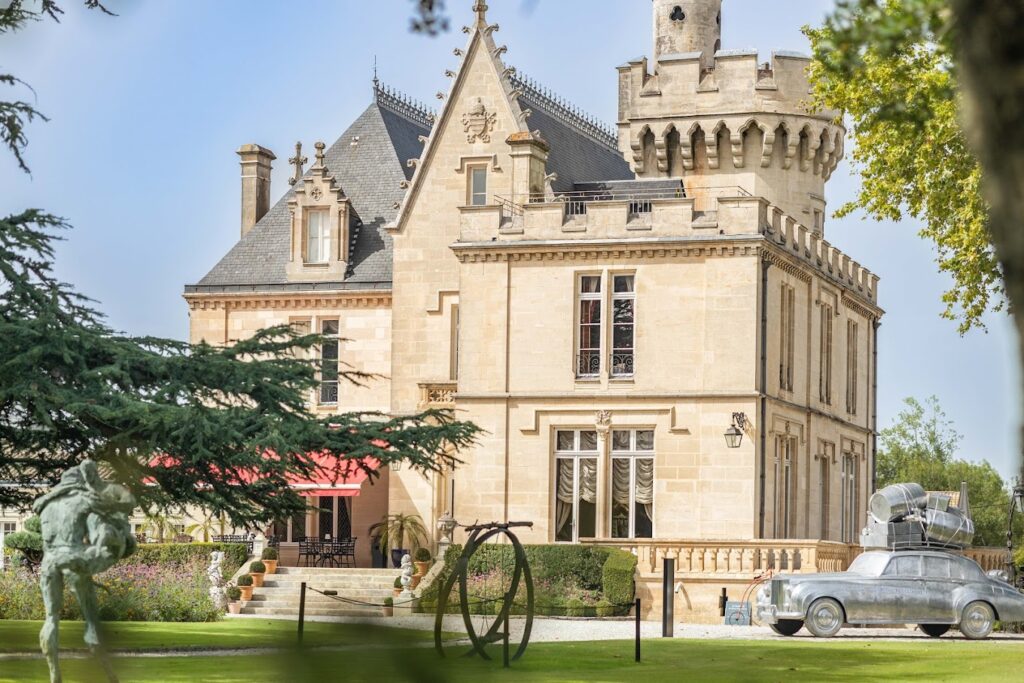
The 16 esteemed châteaux that comprise the Grand Cru Classé de Graves represent the pinnacle of winemaking excellence in this historic region. Each estate brings its own distinctive character and approach to winemaking while upholding the rigorous standards of the classification. Here are just a few we visit regularly.
Château Haut-Brion stands as the undisputed crown jewel of the Graves classification. As the only Graves estate also included in the prestigious 1855 Classification (as a First Growth), it holds a dual distinction that speaks to its extraordinary quality and historical importance.
Dating back to the 16th century, Haut-Brion pioneered many modern winemaking techniques and has maintained its reputation for producing wines of remarkable finesse, complexity, and aging potential. Its red wines offer an elegant profile with notes of dark fruits, tobacco, and an unmistakable gravelly minerality, while its white wines (Haut-Brion Blanc) are among the most sought-after and expensive white wines in the world.
The château's consistent excellence through centuries of production has cemented its status as not just a leader in Graves, but as one of the world's most iconic wine estates.
Located directly across from Château Haut-Brion and now under the same ownership, Château La Mission Haut-Brion has carved out its own distinguished reputation. Often considered the equal of its illustrious neighbor, La Mission produces red wines characterized by power, depth, and remarkable complexity.
The château's red wines typically show greater boldness and concentration than Haut-Brion, with prominent notes of black fruits, smoke, and earth. Its white wine, La Mission Haut-Brion Blanc, rivals its red counterpart in quality and prestige, offering rich textures with honeyed notes balanced by vibrant acidity.
The estate's winemaking philosophy embraces both tradition and innovation, resulting in wines that consistently rank among the finest in Bordeaux and showcase the exceptional potential of the Graves terroir.
Decanter Tours' Tip: Chateau La Mission Haut-Brion is more accessible than Chateau Haut Brion. Both are great to see but we love the gardens at La Mission.
Named after its most famous owner, Pope Clement V, Château Pape Clément boasts one of the longest histories of any Bordeaux wine estate, dating back to the 13th century. This venerable château has distinguished itself through a careful balance of respecting tradition while embracing modern innovations.
Under the stewardship of the well-known Bordeaux wine producer, Bernard Magrez, Pape Clément has implemented cutting-edge viticultural practices, including plot-by-plot harvesting and precision viticulture. The red wines are known for their opulence, concentration, and rich dark fruit profiles, while the whites offer aromatic complexity and remarkable texture.
The chateau is located within the outer ring road of Bordeaux town which makes it one of the few urban wineries that can be found in the area.
Over the past few decades, Château Smith Haut Lafitte has undergone a remarkable transformation under the ownership of Daniel and Florence Cathiard. This revitalization has elevated the estate to new heights while maintaining deep respect for its historical significance.
The château has embraced organic and biodynamic and sustainable principles, establishing its own cooperage and implementing innovative techniques such as using optical sorting technology and gravity-flow systems. These investments in quality have yielded exceptional results. They built their ‘Stealth Cellar’ in 2013 to for grapes from younger vines destined for the second wines of the property; Le Petit Haut Lafitte and Les Hauts de Smith. It was designed to minimise its environmental impact and was built around existing trees, with the moss and shrubs growing on the roof to blend into the environment and increase insulation. The thick walls are built from local materials by local builders and the natural humidity and geothermal heat exchangers maintain cool temperatures. Solar panels help power the cellar and since 2014, CO2 from fermentation is recovered to make bicarbonate of soda
Smith Haut Lafitte's red wines display impressive depth and structure with signature notes of blackberry, truffle, and graphite, while their whites are consistently rated among Bordeaux's finest, offering vibrant citrus notes with distinctive minerality and complexity.
The estate exemplifies how thoughtful modernization can enhance traditional winemaking, resulting in wines that honor their heritage while appealing to contemporary wine enthusiasts.
Decanter Tours' Tip: their Foret des Sens is well worth a stroll on a summers day. This new ‘Land Art’ installation – The Forest of the Five senses is hidden away in almost 20 acres of woods behind Château Smith Haut Lafitte.
The exceptional quality of Grand Cru Classé de Graves wines stems from a perfect alignment of natural advantages and human expertise. These wines capture the essence of their unique terroir while demonstrating the skillful hand of generations of winemakers.
Several factors contribute to their special character:
These combined elements create wines that transcend simple beverage status to become expressions of place, time, and human artistry.
The red wines from Grand Cru Classé de Graves estates showcase a distinctive personality that sets them apart from other Bordeaux appellations. While sharing the region's commitment to excellence, these wines express unique characteristics:
The best examples demonstrate remarkable longevity, with premium vintages continuing to evolve and improve for 30+ years, making them treasured additions to serious wine collections.
The white wines of Grand Cru Classé de Graves stand among the world's most distinctive and age-worthy white wines, challenging the notion that only red wines deserve serious cellaring. These exceptional whites offer a compelling combination of immediate pleasure and long-term potential:
These whites represent some of Bordeaux's most sought-after and expensive white wines, competing with the finest white Burgundies for complexity and aging potential.
The Grand Cru Classé de Graves holds a unique position among Bordeaux's classification systems, with several distinguishing characteristics that set it apart:
Dual Wine Recognition: Unlike the 1855 Classification, which separately classifies Médoc reds and Sauternes whites, the Graves classification recognizes excellence in both red and white wines from the same estates.
Geographic Focus: The classification is exclusively limited to the historic Graves region, focusing on terroir-specific excellence rather than the broader approach of some other classifications.
Historical Context: Established in 1953 and finalized in 1959, it's considerably younger than the 1855 Classification, reflecting post-war quality assessments rather than 19th-century market values.
Static Nature: Like the 1855 Classification, the Grand Cru Classé de Graves has remained unchanged since its establishment, unlike the Saint-Émilion classification which undergoes regular revision.
Qualitative Foundation: The classification was based primarily on wine quality and estate reputation rather than market prices, which heavily influenced the 1855 Classification.
These differences highlight the unique approach and standards of the Grand Cru Classé de Graves, offering wine enthusiasts a different lens through which to appreciate Bordeaux's diverse wine traditions.
Experiencing the magic of Grand Cru Classé de Graves wines in their native setting offers an unparalleled opportunity to understand their true character and heritage. Decanter Tours provides exclusive access to these prestigious estates through carefully curated luxury experiences.
Our specialized Graves tours feature:
Our customizable itineraries can focus exclusively on Grand Cru Classé properties or incorporate them into broader Bordeaux explorations. Transportation is provided in luxury vehicles, and accommodations feature the finest hotels in the region, ensuring your experience matches the prestige of the wines themselves.
Whether you're a serious collector seeking to deepen your knowledge or a wine enthusiast looking to understand what makes these wines so special, a Decanter Tour provides the ultimate way to experience the Grand Cru Classé de Graves.
The Grand Cru Classé de Graves is an official wine classification that recognizes 16 exceptional wine estates in the Graves region of Bordeaux, France. Established in 1953 and finalized in 1959, it distinguishes châteaux that produce wines of outstanding quality, character, and consistency. This prestigious classification is unique in Bordeaux for recognizing both red and white wines from the same estates, highlighting the region's versatility and excellence across different wine styles.
Achieving Grand Cru Classé de Graves status requires meeting stringent criteria across multiple dimensions. Estates must demonstrate exceptional terroir with the characteristic gravelly soils that give the region its name. They must show historical consistency in producing outstanding wines over generations. Their production methods must adhere to the highest standards from vineyard management through winemaking. The wines themselves must display exceptional quality, complexity, and aging potential. Finally, the château must maintain an excellent reputation among wine professionals, critics, and collectors. As the classification has remained unchanged since 1959, these standards represent a historical assessment rather than an ongoing review process.
Exactly 16 châteaux hold the prestigious Grand Cru Classé de Graves designation. This limited number underscores the exclusivity and high standards required for inclusion. The classified estates include some of Bordeaux's most famous names, such as Château Haut-Brion (which is also a First Growth in the 1855 Classification), Château La Mission Haut-Brion, Château Pape Clément, and Château Smith Haut Lafitte. All 16 estates produce classified red wines, while several also produce exceptional white wines that carry the classification, making it unique among Bordeaux's classification systems for recognizing both wine styles.
Yes, many Grand Cru Classé de Graves châteaux welcome visitors, though typically by appointment only. These estates offer various visiting experiences, from standard tours and tastings to more exclusive private experiences. The level of access varies by château, with some offering intimate tastings with winemakers or owners, while others provide structured group experiences. For the most comprehensive and privileged access, specialized wine tour companies like Decanter Tours can arrange VIP visits that include private tastings of library vintages, meetings with château principals, and behind-the-scenes access not available to the general public. Visiting during harvest season (September-October) provides unique insights into the winemaking process, though availability may be more limited as estates focus on production.
Graves, one of Bordeaux's key wine-producing regions, offers a fascinating journey into the heart of French winemaking. This article explores the unique characteristics of Graves' terroir, its famous wines, and renowned châteaux, providing a comprehensive overview of this prestigious appellation.
The terroir of Graves is a defining factor in its wine production. The region's diverse soils, composed primarily of gravel, clay, and limestone, create a complex mosaic that influences the character of the wines. Gravelly soils, a hallmark of Graves, provide excellent drainage, forcing vine roots to delve deep in search of water and nutrients. This struggle results in concentrated flavors and contributes to the wine's aging potential. Clay soils, often found in conjunction with gravel, add richness and body to the wines. Limestone, when present, contributes minerality and freshness. These diverse soil types, coupled with the region's unique microclimates, create a terroir that is perfectly suited for producing exceptional wines. The temperate, oceanic climate further contributes to the quality of the grapes.
The varied soils of Graves have a profound impact on the complexity of its wines, creating a terroir that has been prized since Roman times. The region's name itself comes from its distinctive gravelly soils, composed of quartz, flint, and quartzite deposits left behind by ancient glaciers and rivers. These gravel soils, some reaching depths of several meters, serve multiple crucial functions in wine production. During the day, they absorb heat from the sun and reflect it back onto the vines, helping achieve optimal ripeness in Bordeaux's maritime climate. At night, this stored heat creates a moderating effect that protects vines from frost damage. Most importantly, the exceptional drainage of these gravelly soils forces vine roots to grow deeply – sometimes up to 15-20 meters – in search of water and nutrients, resulting in wines with remarkable mineral complexity and what the French call "tension."

The subsoils of Graves add another dimension to its wines. Below the gravel, layers of clay and limestone create a complex underground environment that directly influences wine character. Clay-rich areas, particularly prevalent in the northern parts of Graves, retain moisture and provide essential nutrients that contribute to the wine's structure and body. These soils tend to produce wines with greater opulence and richer tannins, especially beneficial for Merlot. The limestone substrata, meanwhile, supplies crucial minerals and maintains optimal soil pH, leading to wines with bright acidity and pronounced mineral notes – characteristics that make Graves whites particularly acclaimed.
This intricate soil composition creates a natural stress environment for the vines, where they must work harder to survive. This struggle translates directly into wine quality. The restricted water access results in smaller berries with higher skin-to-juice ratios, producing more concentrated flavors and complex phenolic compounds. These conditions particularly benefit Cabernet Sauvignon, allowing it to develop its characteristic graphite and smoky notes that are hallmarks of aged Graves reds.
The soil's influence on aging potential is equally significant. Wines from the gravelly plateaus typically show excellent aging capacity due to their balanced acidity and structured tannins – a direct result of the vine's deep root systems. Red wines from these soils often develop complex tertiary aromas of tobacco, leather, and truffle with age, while whites maintain their freshness and develop intriguing honey and beeswax notes over time.

The grape varieties of Graves also reflect centuries of viticultural wisdom, with each variety carefully chosen to express the region's distinctive terroir. For red wines, Cabernet Sauvignon typically dominates the blend, particularly in the gravelly soils where it thrives. Here, it develops intense cassis and blackcurrant flavors, along with its signature graphite and cedar notes that become more pronounced with age. The well-draining gravel soils allow Cabernet Sauvignon to achieve optimal ripeness while maintaining the fresh acidity that makes Graves reds so age-worthy. In warmer vintages, these wines often display additional layers of black cherry and subtle tobacco notes.

Merlot, the second major red variety, plays a crucial complementary role in Graves blends. It particularly excels in the region's clay-limestone soils, where it develops rich plum and black fruit characteristics with subtle chocolate undertones. Merlot's natural roundness helps soften Cabernet Sauvignon's firm tannins, creating wines of remarkable balance. The proportion of Merlot in blends often increases in cooler vintages or in plots with more clay, where it ripens more reliably than Cabernet Sauvignon.

Cabernet Franc, though used in smaller quantities, contributes significantly to the complexity of Graves reds. It adds aromatic lift with its distinctive violet and pepper notes, while also providing structure and freshness. Some producers, particularly in warmer vintages, may include small amounts of Petit Verdot, which brings additional spice, color, and tannin structure to the final blend.
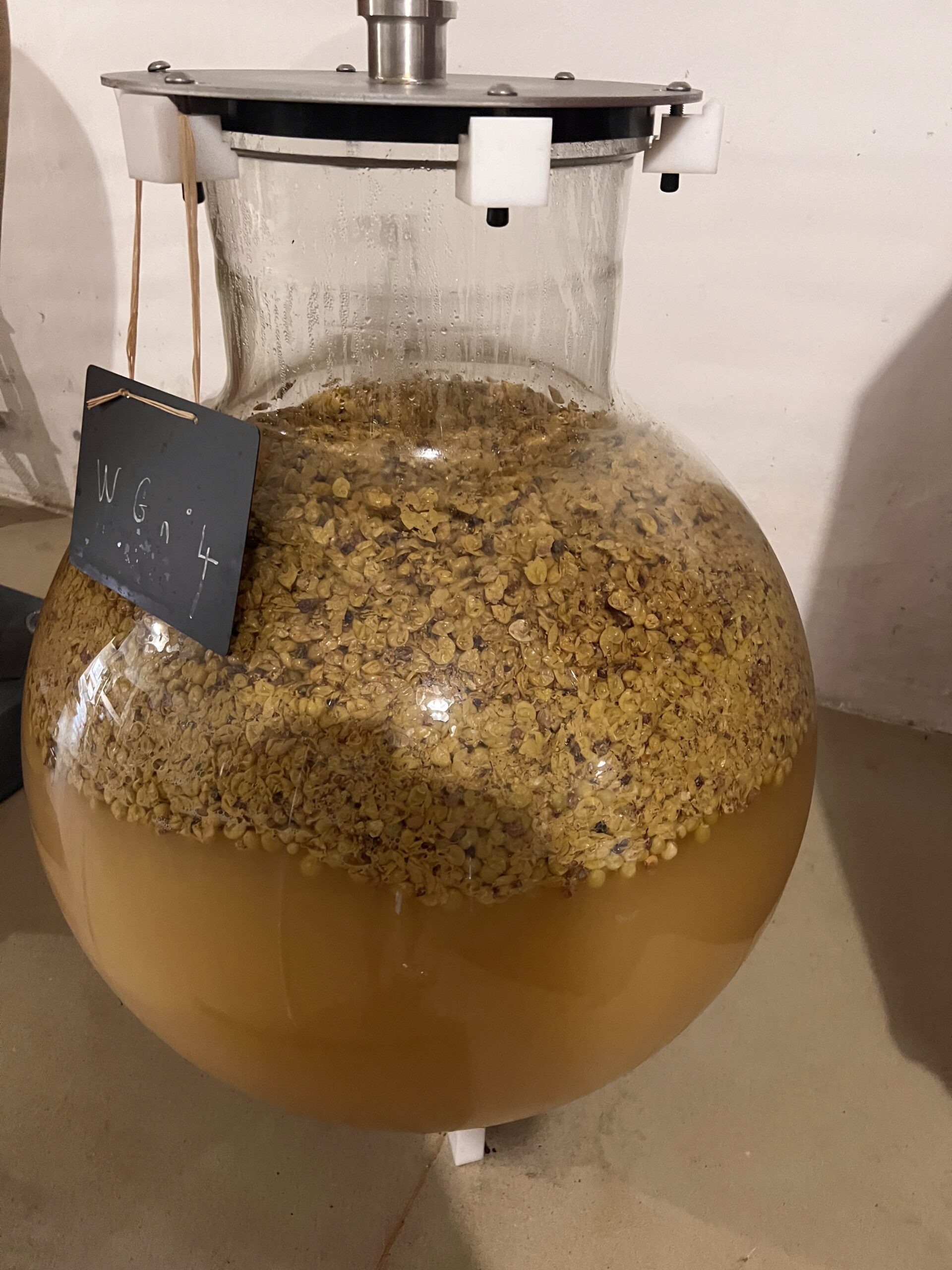
The white wines of Graves are equally distinguished, built primarily around the brilliant partnership of Sauvignon Blanc and Sémillon. Sauvignon Blanc, when grown in Graves' gravelly soils, develops intense citrus and gooseberry flavors along with distinctive mineral notes. The region's climate allows it to achieve full aromatic expression while maintaining crucial acidity. Sémillon, contributing between 20% to 50% of most white blends, provides weight and texture, adding honeyed notes and a waxy richness that becomes more pronounced with age. This grape variety shows particular affinity for the limestone-clay soils, where it develops complex stone fruit characters and a distinct lanolin quality.
Muscadelle, though typically comprising less than 5% of white blends, plays an important aromatic role. It contributes delicate floral notes and subtle muscat character that complement the primary varieties. Some producers also maintain small plantings of traditional varieties like Sauvignon Gris, which can add extra complexity to their white blends.
The proportions of these varieties in both red and white blends vary not only by producer but also by specific vineyard sites within their estates. This flexibility allows winemakers to adapt their blends to both their terroir and the characteristics of each vintage, contributing to the remarkable consistency and quality for which Graves is known.
Graves produces three main styles of wine: red, dry white, and sweet.
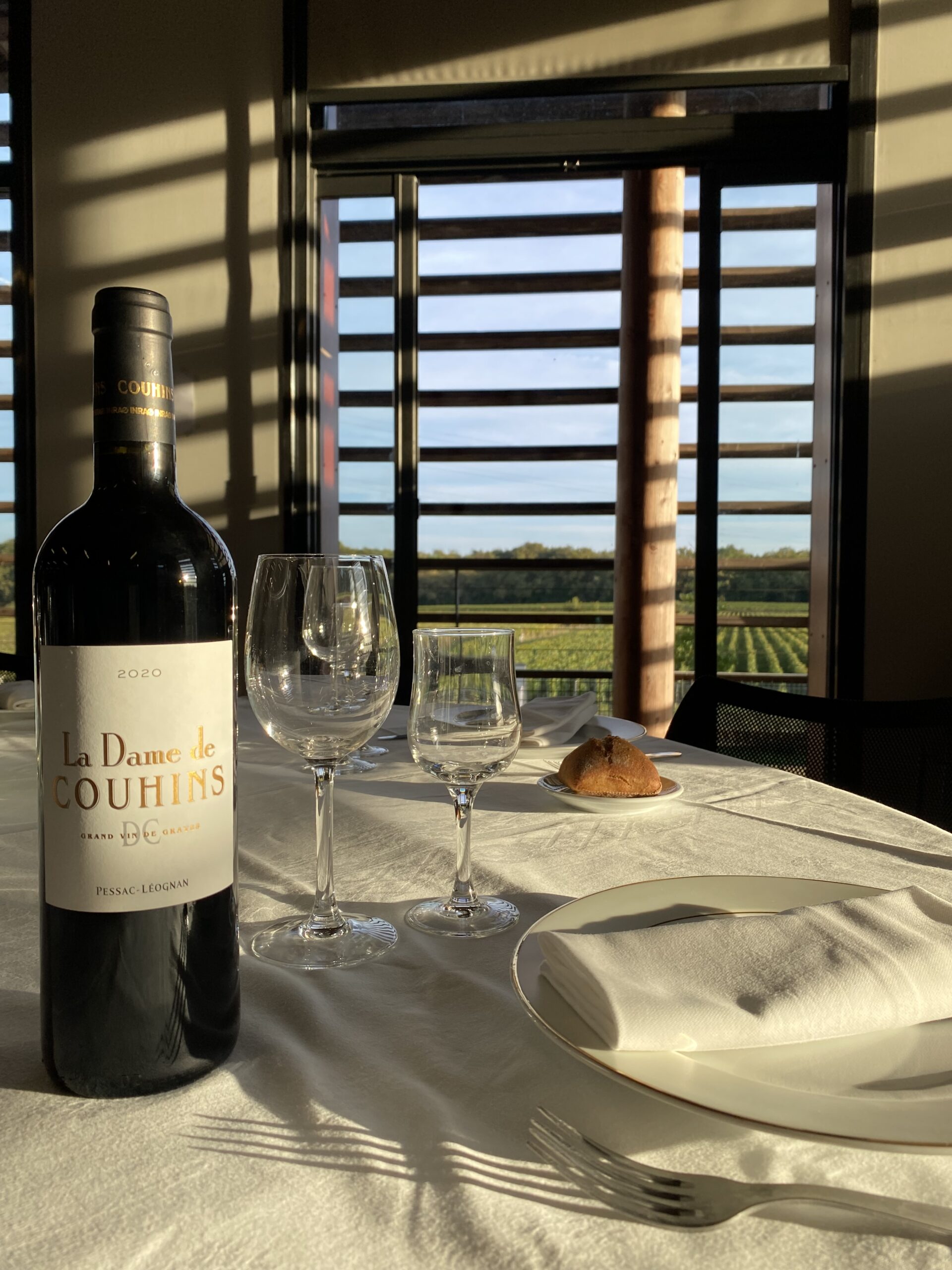
Graves red wines are distinguished by their remarkable balance and finesse, offering a masterful demonstration of how terroir can shape wine character. Unlike the muscular wines of the Médoc or the plush richness of Saint-Émilion, Graves reds exhibit an ethereal elegance that has captivated wine enthusiasts for centuries. The structure of these wines is built around refined, silky tannins that provide framework without aggression – a characteristic directly linked to the region's gravelly soils and maritime climate.
In their youth, Graves reds display a complex aromatic profile that begins with fresh red fruits like wild strawberry and red cherry, often accompanied by black fruits such as cassis and blackberry. These primary fruit notes are complemented by distinctive mineral characteristics – particularly a gravelly, almost smoky quality that wine critics often describe as "gun flint." The region's proximity to pine forests influences the wines' aromatic complexity, sometimes contributing subtle resinous notes that add another layer of sophistication.
With age, these wines undergo a fascinating transformation. The primary fruit evolves into dried fruit characters, while secondary aromas of leather, tobacco, and forest floor emerge. Most impressive is the development of the region's signature "gravelly" mineral notes, which become more pronounced over time, creating an almost ethereal quality in mature wines. Premium examples from top producers can age gracefully for two to three decades, though many wines show their best between 8-15 years.
The dry white wines of Graves represent some of the world's most sophisticated white wine expressions, distinguished by their remarkable combination of power and precision. These wines showcase how the marriage of terroir and traditional grape varieties can create something truly extraordinary. The interplay between Sauvignon Blanc's vivacity and Sémillon's richness creates wines of remarkable complexity and age-worthiness – a characteristic that sets them apart from many other white wines globally.
In their youth, these wines display an intense aromatic profile that begins with citrus notes – often lime and grapefruit – complemented by white peach, green apple, and subtle tropical fruits. The region's distinctive mineral character manifests as wet stone and sometimes smoky notes, particularly in wines from the most gravelly sites. There's often a fascinating tension between the wine's rich texture and its vibrant acidity, creating a dynamic tasting experience that evolves in the glass.
With bottle age, Graves whites develop remarkable complexity. The fresh fruit notes evolve into dried apricot and candied citrus, while secondary aromas of honey, beeswax, and toasted nuts emerge. The mineral character becomes more pronounced, and the texture gains additional depth while maintaining freshness – a characteristic that makes aged Graves whites particularly sought after by collectors.
While the sweet wines of Graves may live in the shadow of their famous neighbors in Sauternes, they offer a distinctive and often more approachable interpretation of noble rot-affected wines. The key difference lies in their balance and style. Where Sauternes often presents intense concentration and high levels of residual sugar, Graves sweet wines typically show more restraint and delicacy, making them particularly versatile with food.

These wines are crafted primarily from Sémillon, with smaller proportions of Sauvignon Blanc and occasionally Muscadelle. The noble rot (Botrytis cinerea) that affects the grapes develops differently here than in Sauternes, often resulting in wines with more moderate sugar levels but equally complex flavor profiles. The initial taste presents honeyed notes balanced by fresh citrus and stone fruit, with subtle botrytis character adding layers of dried apricot, orange marmalade, and exotic spices.
As these wines age, they develop intriguing tertiary characteristics of dried fruits, nuts, and subtle mushroom notes, while maintaining better acidity than many other sweet wines. This makes them particularly interesting for gastronomy, as they can pair beautifully with both savory dishes and desserts. While they may not have the longevity of classic Sauternes, quality examples can age gracefully for 15-20 years, developing additional complexity while maintaining their characteristic freshness and balance.
Graves is home to some of the most prestigious châteaux in Bordeaux, including:
Château Haut-Brion: The first Bordeaux wine ever mentioned in writing by name (Samuel Pepys' diary, 1663), marking its historical significance in fine wine culture. Visitors can experience the unique opportunity to taste both Haut-Brion and La Mission Haut-Brion side by side, offering insight into how subtle terroir differences affect wine character within meters of each other.
Château Pape Clément: Named after Pope Clement V and operating continuously since 1252, making it one of Bordeaux's oldest working wineries. The estate offers hands-on wine blending workshops where visitors can create their own custom blend, providing a rare interactive experience in understanding wine composition.
Château La Mission Haut-Brion: Founded by missionaries, it still maintains its original chapel where unique vertical tastings are conducted today. This extraordinary setting combines historical spirituality with wine appreciation, creating an unmatched tasting atmosphere in Bordeaux.

Château Haut-Brion stands as a testament to the timeless pursuit of wine excellence, holding a unique position as both a First Growth and the oldest of Bordeaux's great wine estates. Its remarkable history dates back to 1525, when Jean de Pontac began assembling the estate. The château gained international recognition in 1663 when Samuel Pepys famously wrote in his diary about discovering "a good and most particular taste that I never met with" after tasting Haut-Brion at the Royal Oak Tavern in London – marking the first time a specific wine estate was mentioned in literature.
The château's exceptional terroir sets it apart even within the prestigious Graves region. Its 51 hectares of vineyards sit atop deep gravel beds mixed with clay and sand, creating a unique microclimate that protects vines from both spring frosts and summer drought. This distinctive soil composition, combined with careful vineyard management, produces grapes with extraordinary concentration and complexity. The estate's location within the urban area of Pessac has created a unique microclimate that often allows earlier ripening than other Bordeaux estates.
Haut-Brion's red wines are renowned for their distinctive aromatic profile, often described as featuring a unique "cigar box" or "tobacco" character that sets them apart from other First Growths. The blend typically features a higher proportion of Merlot than other First Growths, contributing to its characteristic velvety texture and approachability in youth, while maintaining impressive aging potential. The estate's white wine, among the most sought-after dry whites in the world, demonstrates how the terroir can produce whites of extraordinary complexity and longevity.

Château Pape Clément offers visitors a unique journey through eight centuries of winemaking history, combined with modern luxury and innovation. Founded in 1252 by Bertrand de Goth, who later became Pope Clement V, the estate represents one of the oldest continuously operating wineries in France. The château's 60 hectares of vineyards are meticulously maintained using a combination of traditional methods and cutting-edge technology, including the use of draft horses for soil maintenance in certain plots to prevent soil compaction.
Visitors to Pape Clément experience something truly special – the chance to walk through vineyards where ancient viticultural practices meet modern innovation. The estate's unique workshop program allows wine enthusiasts to participate in hands-on blending sessions, where they can understand the artistry behind creating the perfect balance in a Bordeaux blend. The château's spectacular barrel room, with its dramatic lighting and centuries-old stone walls, provides an atmospheric setting for tastings that feature both young wines and carefully cellared older vintages.
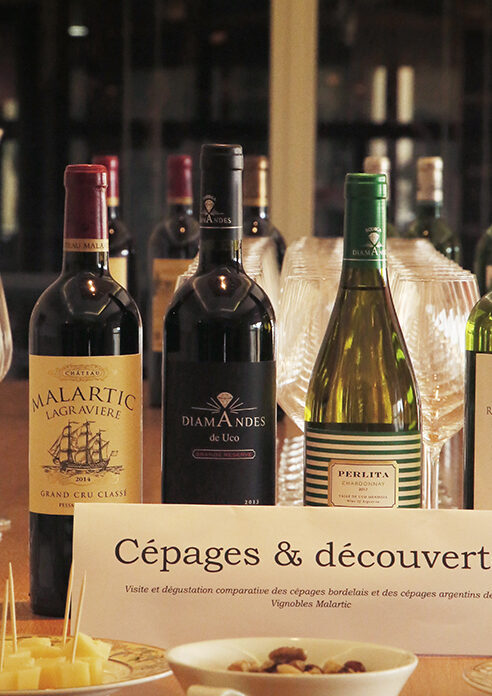
Selecting quality Graves wines requires understanding several key indicators that reflect the region's strict quality standards. The appellation system provides the first level of quality assurance, with wines labeled "Graves" or "Pessac-Léognan" (for wines from the northern part of Graves) meeting strict production criteria. The 1959 classification, which recognized 16 châteaux for their exceptional quality, serves as another valuable guide for consumers seeking the region's finest wines.
When examining labels, look for specific vineyard sites or "lieu-dit" names, as these often indicate particularly prestigious terroirs within the appellation. The vintage plays a crucial role – while great producers make good wines even in challenging years, exceptional vintages like 2000, 2005, 2009, 2010, 2015, and 2016 often produce wines of remarkable quality and aging potential.
Description: Explains the importance of the AOC (Appellation d'Origine Contrôlée) system in guaranteeing the authenticity and quality of Graves wines, helping consumers make informed purchases. Mention also the “1959 classification” to put the link to the article “Discover the Grand Cru Classé de Graves: history, criteria, and the 16 classified Châteaux”.
The Appellation d'Origine Contrôlée (AOC) system in Graves represents one of France's most rigorous quality control frameworks, serving as a guarantee of authenticity and excellence in winemaking. This system, established in 1937 for Graves, goes far beyond simple geographical boundaries - it encompasses a complete set of regulations that shape every aspect of wine production.
Within Graves, the AOC system operates on multiple levels. The base appellation "Graves" sets fundamental quality standards, while the more prestigious "Pessac-Léognan" appellation, created in 1987, represents the historical heart of the region and typically produces wines of even higher quality. The requirements for these appellations are exacting and comprehensive. For red wines, only Cabernet Sauvignon, Merlot, Cabernet Franc, and small amounts of Petit Verdot are permitted. White wines must be crafted primarily from Sauvignon Blanc and Sémillon, with limited use of Muscadelle. Beyond grape varieties, the AOC system regulates:
Vineyard Management: Strict controls on vine density (minimum 6,500 vines per hectare in Pessac-Léognan), pruning methods, and yield restrictions (maximum 48 hectoliters per hectare for reds and 45 for whites) ensure optimal grape quality. These dense plantings force vines to compete, driving roots deeper into the soil and producing more concentrated fruit.
Harvesting and Vinification: The AOC mandates hand-harvesting for classified growths and sets minimum potential alcohol levels before harvest. Vinification must take place within the appellation boundaries, ensuring local expertise and traditional methods are maintained.
The 1959 classification adds another layer of distinction, recognizing 16 châteaux as Crus Classés de Graves. These estates represent the pinnacle of quality in the region, often exceeding the basic AOC requirements through even stricter self-imposed standards. This classification remains highly relevant today, serving as a reliable guide for consumers seeking exceptional wines.
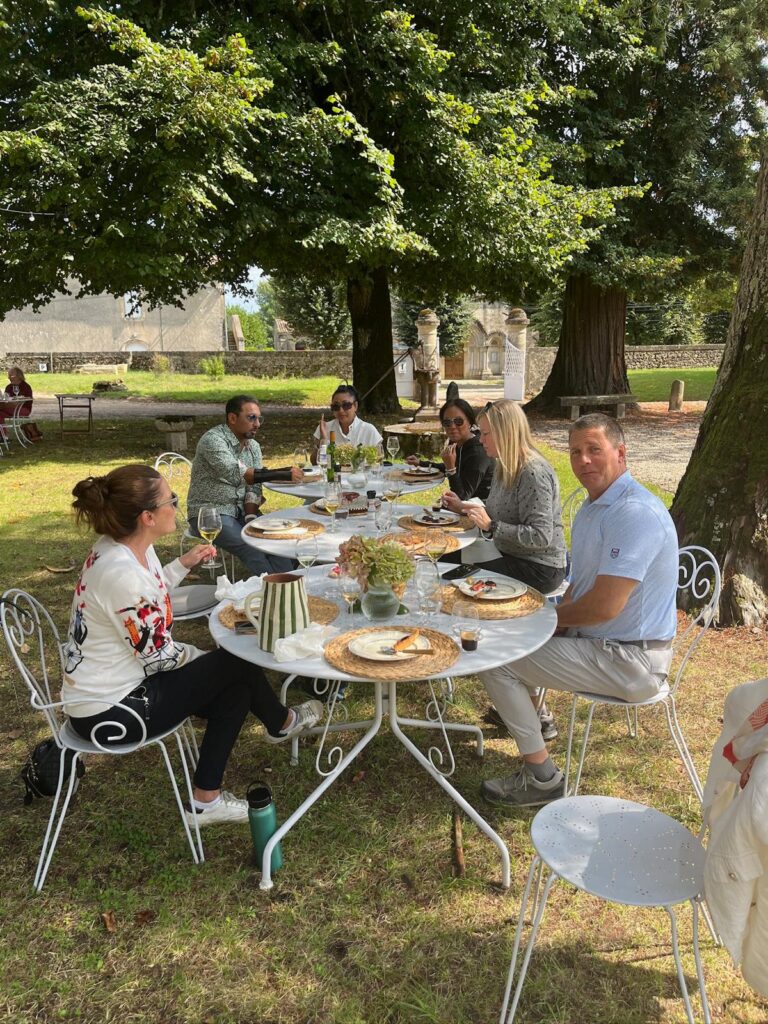
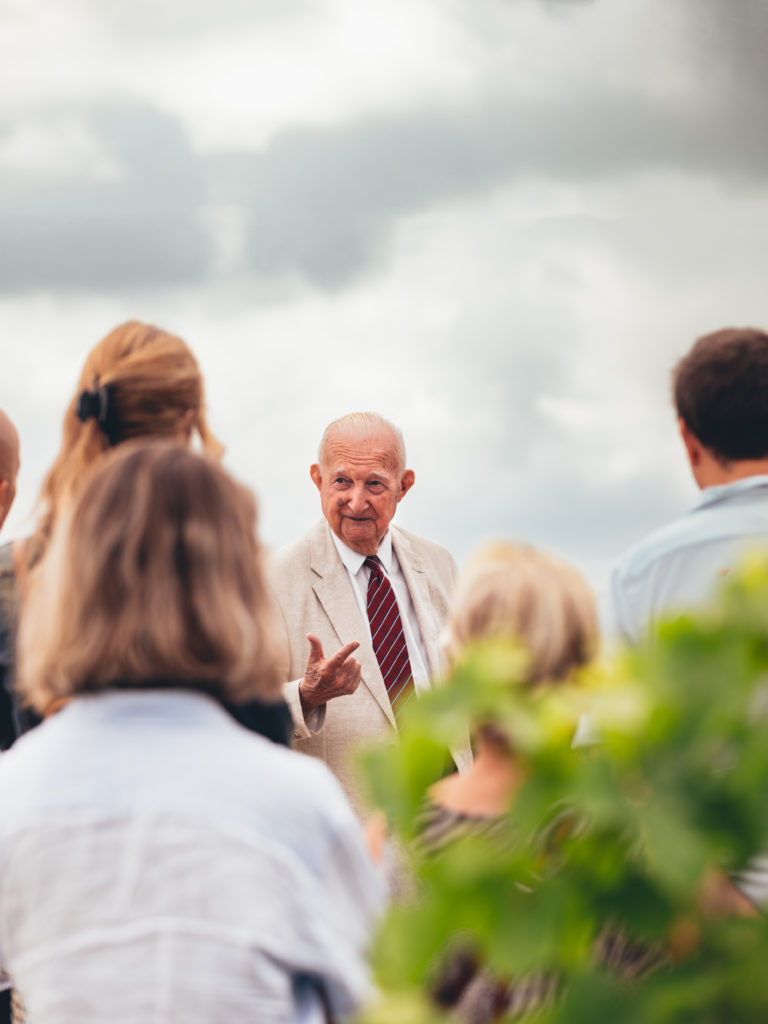
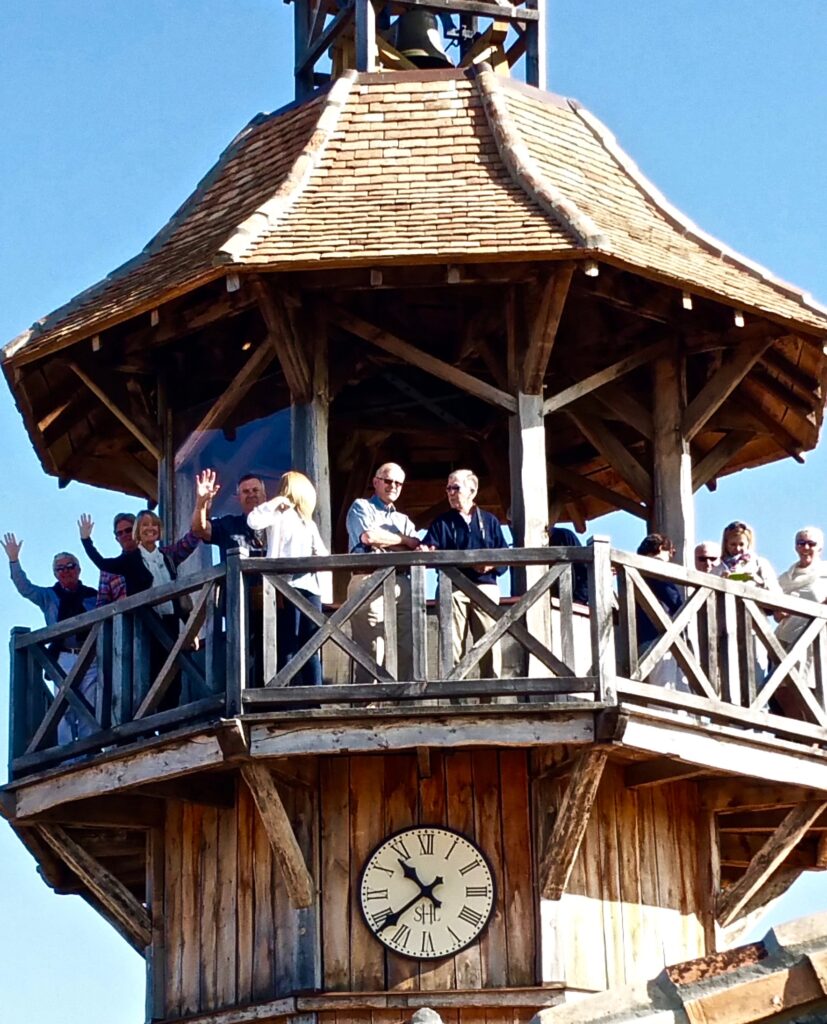
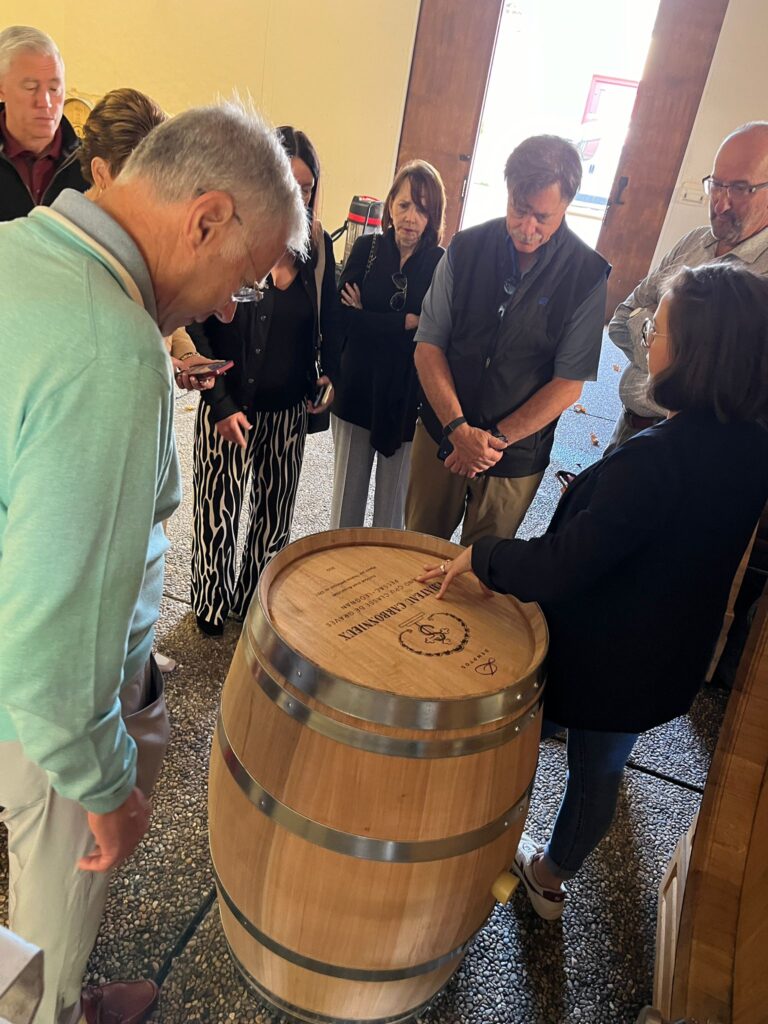
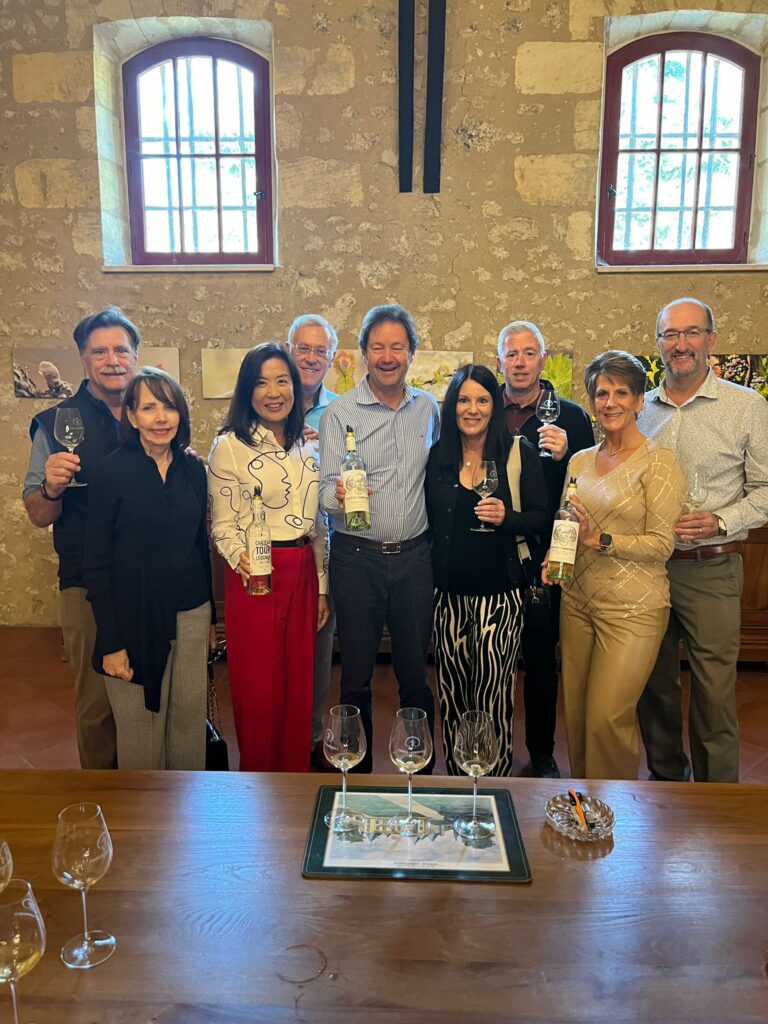
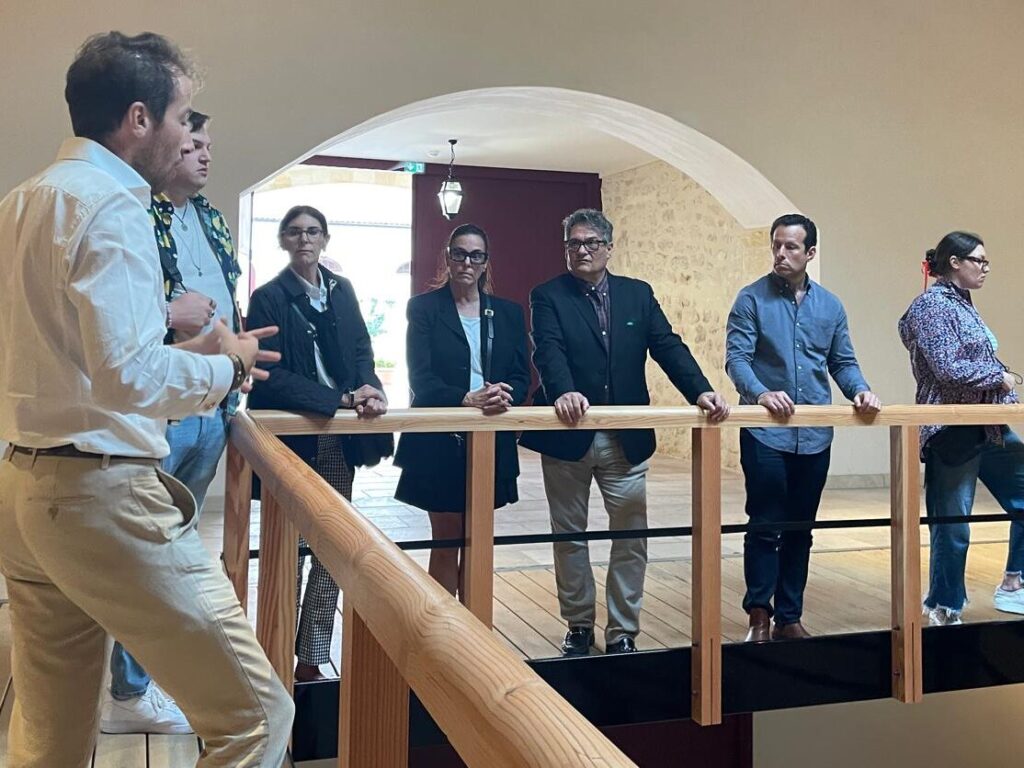
Decanter Tours offers an unparalleled journey into the heart of Graves, crafting experiences that go beyond traditional wine tasting to create deep, meaningful connections with this historic region. Our carefully curated tours provide privileged access to estates that are often closed to the public, allowing you to discover the soul of Graves luxury tour through its most prestigious châteaux and hidden gems.
Your journey begins with personalized consultation to understand your wine preferences and interests, enabling us to tailor the perfect itinerary. Our expert sommeliers, who possess intimate knowledge of the region, serve as your personal guides, offering insights that go beyond standard tours. They share not just technical knowledge about wine production, but also the fascinating stories, histories, and personalities that make each château unique.
A typical day might include:
For the truly passionate, we can arrange special experiences such as:
Our relationships with the châteaux ensure that you experience Graves not as a tourist, but as a privileged guest, gaining insights and access typically reserved for wine trade professionals. Whether you're a serious collector or an enthusiastic newcomer to fine wine, our tours provide an unforgettable journey into one of the world's most prestigious wine regions.
Transform your passion for fine wines into an unforgettable journey through one of Bordeaux's most prestigious regions. Whether you dream of exclusive tastings at classified growths, intimate conversations with renowned winemakers, or discovering hidden gems off the beaten path, Decanter Tours will craft your perfect Graves experience. Contact us today to begin planning your bespoke wine adventure in Graves. Our wine experts are ready to design an itinerary that matches your interests and exceeds your expectations. From first-time visitors to seasoned collectors, we ensure every guest experiences the magic of Graves in a way that speaks to their personal wine journey.
Email us at info@decantertours.com or call +1 (888) 727-8127 to start planning your extraordinary Graves wine tour. Your perfect Bordeaux moment awaits.
Red wines: Cabernet Sauvignon, Merlot, Cabernet Franc. White wines: Sauvignon Blanc, Sémillon, Muscadelle.
Red wines: Red meats, game, hearty stews. White wines: Seafood, shellfish, lighter dishes.
Château Haut-Brion, Château Pape Clément, Château La Mission Haut-Brion.
Imagine rolling hills blanketed with vineyards, the Garonne River glistening in the distance, and the distinct crunch of gravel beneath your feet. This isn't a dream; it's Graves, the cradle of Bordeaux wine, a region where history and terroir intertwine to create wines of exceptional character and a travel experience that resonates with every wine lover. More than just a geographical location, Graves is a narrative, a story told through its wines, its landscapes, and its people.
Graves, a historic and geographically significant region within Bordeaux, France, offers a captivating blend of rich winemaking tradition and stunning landscapes. This region, the birthplace of Bordeaux wines, invites you to explore its vineyards, delve into its fascinating past, and savor its distinctive wines. From its unique terroir to its charming towns, Graves promises an unforgettable experience for wine lovers and history buffs alike.

Graves isn't just in Bordeaux; it's where the Bordeaux story began. Situated south of the city of Bordeaux, on the left bank of the Garonne River, Graves holds a unique position in the region's viticultural landscape. The Garonne, a vital artery for the region, moderates the climate and has played a crucial role in shaping the terroir for centuries. Its proximity to Bordeaux makes it easily accessible for visitors, yet Graves retains a distinct identity, a connection to the origins of Bordeaux winemaking that you won't find anywhere else. Think of it as the ancestral home of Bordeaux wine, where the traditions and techniques that made the region famous were first established.
What truly sets Graves apart is its remarkable geological diversity. The name itself, "Graves," is a direct reference to the region's defining characteristic: its gravelly soil. But it's not simply "gravel"; it's a complex mosaic of different types of gravel – from small, rounded pebbles to larger, more angular stones – interspersed with clay, sand, and limestone deposits. These gravelly soils, sometimes reaching depths of 12 meters or more, act as a natural drainage system, preventing waterlogging and forcing vine roots to delve deep, sometimes over 20 meters, into the earth in search of nourishment. This "struggle" for survival results in lower yields, but it also concentrates the flavors in the grapes, leading to wines of exceptional complexity, structure, and aging potential. Imagine the vines as artists, sculpting their masterpieces from the very earth they inhabit.

The Garonne River plays a crucial role in this geological drama. It not only moderates the climate, creating beneficial microclimates, but also influences the soil composition through erosion and deposition. The river's presence, combined with the diverse soils and the temperate oceanic climate, creates a unique terroir that is the foundation of Graves' distinctive wines. The climate, with its mild temperatures, ample rainfall, and long, sun-drenched summers, allows the grapes to ripen slowly and evenly, developing complex aromas and flavors. It's a delicate balance of nature's elements, a perfect harmony that allows Graves to produce wines of such exceptional quality.

The gravel-rich soils of Graves are more than just a geological feature; they are the key to understanding the region's wine quality. The excellent drainage provided by the gravel prevents waterlogging, which can dilute flavors and promote fungal diseases. This allows the vines to thrive and develop deep, extensive root systems, accessing deeper water reserves and a wider range of minerals. This, in turn, translates into more concentrated flavors, richer aromas, and a greater depth of character in the wines. The gravel also acts as a natural heat reflector, radiating warmth back onto the grapes and aiding in ripening, contributing to the development of phenolic compounds, which are essential for color, tannins, and aging potential. These well-drained soils, combined with the other geological components, contribute significantly to the remarkable aging potential of Graves wines, allowing them to evolve and develop beautifully over decades.
Graves doesn't just produce wine; it embodies a history that stretches back to Roman times. The Romans, recognizing the region's potential for viticulture, planted the first vines, laying the foundation for what would become one of the world's most prestigious wine regions. Graves played a crucial role in establishing Bordeaux as a major wine capital. During the Middle Ages, the wines of Graves, particularly its claret (red Bordeaux), were highly prized in England. The export of Graves wines to England, beginning as early as the 12th century, had a profound impact on the development of the Bordeaux wine trade, shaping its reputation for quality and prestige. It was the wines of Graves that first commanded high prices and established Bordeaux's reputation for fine wine. From the 15th to the 18th centuries the Graves was known for its excellent wines and had a high level of exports. The very name "Graves," derived from the gravelly soil ("graves" in French), is a testament to the region's defining characteristic and its enduring legacy.
Graves wasn't just part of the Bordeaux wine trade; it launched it. Its wines, particularly the red wines, were highly sought after, especially by the English market which started from the 12th century. This demand fueled the growth of the Bordeaux wine industry and cemented Graves' position as a key player. The region's success in exporting its wines, often through the bustling port of Bordeaux, laid the groundwork for the wider Bordeaux wine trade to flourish, solidifying its position as a leading wine region. Graves' influence can still be tasted in every bottle of Bordeaux, a testament to its pioneering spirit.
Graves offers more than just exceptional wines; it offers a journey into the heart of French culture and history. Explore the region's rich heritage by visiting historical landmarks, including ancient churches, majestic castles (chateaux), and impressive monuments. The Château de la Brède, the birthplace of Montesquieu, the renowned political philosopher, is a must-see for history enthusiasts. Indulge in the region's gastronomy, savoring traditional French cuisine that perfectly complements the local wines. From hearty dishes like entrecôte bordelaise (steak with Bordeaux sauce) to delicate seafood from the nearby coast, Graves offers a culinary adventure as rich and diverse as its wines. The charming towns and villages of Graves, such as Léognan, Barsac, and Sauternes, each with their own unique character and charm, offer a glimpse into authentic French life and provide a welcome escape from the hustle and bustle of modern life.
Graves is an ideal destination for wine lovers seeking an authentic and immersive experience. The region's scenic beauty, tranquil atmosphere, and welcoming chateaux create a charming setting for vineyard visits and wine tastings. Explore the local touristic routes, such as the Graves Wine Route, and discover hidden gems among the vineyards. The accessibility of the vineyards allows for intimate and informative tours, providing a deeper understanding of the winemaking process and the unique terroir of Graves. Many chateaux offer tours and tastings, allowing visitors to experience the hospitality and passion of the winemakers firsthand. It's an opportunity to connect with the people who craft these exceptional wines and to appreciate the dedication and artistry that goes into every bottle.
Beyond wine tours, Graves offers a wealth of activities to enrich your visit, catering to a variety of interests. Hike or bike through the picturesque countryside, immersing yourself in the natural beauty of the region. For a different perspective on the landscape, consider kayaking or canoeing down the Cérons River. This gentle river meanders through the heart of the Graves region, offering a tranquil and scenic way to experience the natural beauty of the area, passing by vineyards and charming villages along the way.
Visit local markets to discover regional products, from fresh produce to artisanal cheeses, and interact with local producers. Leognan has a Saturday morning market and La Breda on Wednesdays. Explore the small towns and villages, each with its own unique charm and history. Engage with the local culture and experience the authentic French lifestyle. Consider taking a cooking class focused on regional cuisine or visiting a local artisan workshop to delve deeper into the traditions and crafts of Graves.
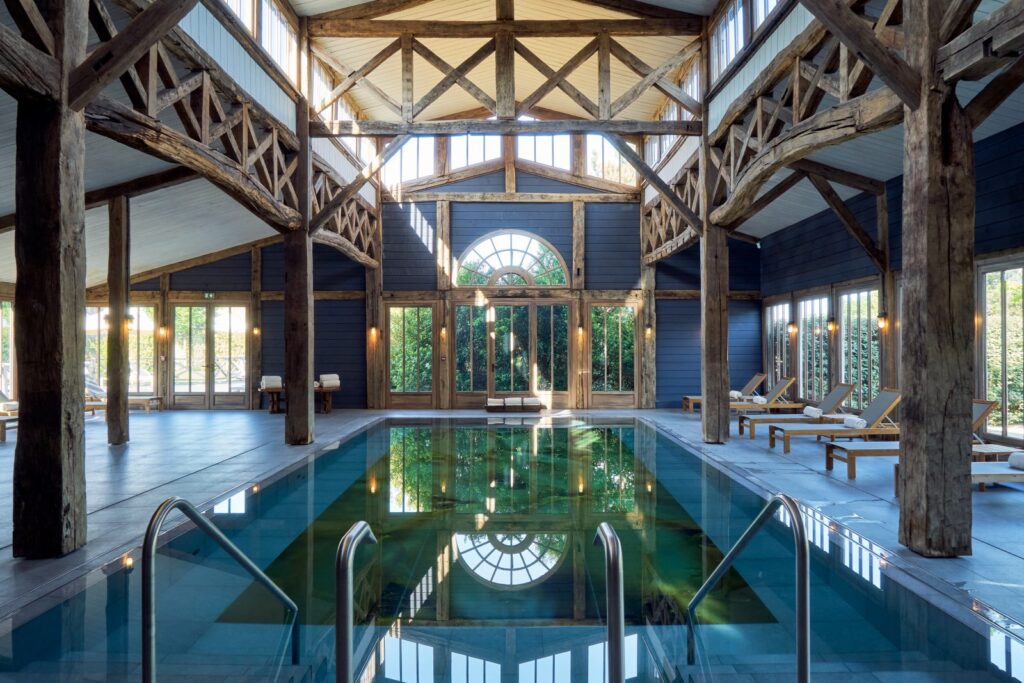
For those seeking relaxation and rejuvenation after a day of exploring, a spa day at Les Sources de Caudalie is an absolute must. This luxurious spa, nestled amidst the vineyards, offers unique vinothérapie treatments, utilizing the power of grapes and grapevines. Indulge in a barrel bath, where you soak in a warm bath infused with grape extracts, known for their antioxidant properties. Or perhaps a Merlot mud wrap, a luxurious treatment that leaves your skin feeling soft and revitalized, is more your style. Les Sources de Caudalie provides the perfect pampering experience to complement your wine-centric journey through Graves.
To truly understand the magic of Graves, consider a private wine tour. A personalized tour allows you to delve deeper into the region's nuances, guided by a knowledgeable expert. A sommelier or wine professional can provide invaluable insights into the history, terroir, and winemaking techniques of Graves, enriching your understanding and appreciation of the wines. A private tour also offers unparalleled flexibility, allowing you to tailor your itinerary to your specific interests and visit the chateaux that intrigue you most. Consider a tour that includes not only the prestigious classified growths but also some of the smaller, family-run estates, for a more complete and intimate portrait of the Graves wine region. It's an opportunity to unlock the secrets of Graves, to taste the history and passion that are poured into every glass.
Ready to uncork the magic of Graves? Immerse yourself in the history, terroir, and exquisite wines of this legendary Bordeaux region. Decanter Tours specializes in crafting unforgettable wine experiences, tailored to your specific tastes. Whether you're a seasoned connoisseur or just beginning your wine journey, our expert-led tours will unlock the secrets of Graves, from its prestigious châteaux to its hidden gems. Don't just dream about exploring this captivating region – make it a reality. Contact Decanter Tours today to book your private Graves wine tour and embark on a sensory adventure you won't soon forget! Visit our website or email us at info@decantertours.com to start planning your perfect Graves escape.
Graves is located south of Bordeaux, on the left bank of the Garonne River, in the Aquitaine region of southwestern France.
Graves is distinguished by its gravelly soils, which are ideal for Cabernet Sauvignon and contribute to the structure and aging potential of its wines. It is also the historical birthplace of Bordeaux wine.
Graves offers historical landmarks, charming villages, local markets, and opportunities for hiking and cycling through the scenic countryside. The gastronomy of the region is also a major draw.
Graves offers an authentic and immersive wine experience, with beautiful scenery, welcoming chateaux, and accessible vineyards. It is a great place to learn about wine making, taste exceptional wines and enjoy the French way of life.
Many wine lovers find themselves pondering the difference between Bordeaux and Cabernet Sauvignon. The simple answer is: a Bordeaux can contain Cabernet Sauvignon, but a Cabernet Sauvignon is often not a Bordeaux. This article will clarify this common confusion, exploring the grape varieties, regions, winemaking techniques, and taste profiles that distinguish these two wine categories. Understanding these nuances is essential for any wine enthusiast looking to deepen their appreciation of fine wines, especially if you are considering a Bordeaux wine tour.
A key point to remember is that Bordeaux refers to a specific wine region in France, while Cabernet Sauvignon is a grape variety. Bordeaux wines are typically blends of several grape varieties, whereas Cabernet Sauvignon is often bottled as a single-varietal wine. This fundamental difference significantly impacts the final product.
Bordeaux, one of the world’s most prestigious wine regions, is renowned for its blended red wines. These complex and balanced wines typically combine Cabernet Sauvignon, Merlot, Cabernet Franc, Petit Verdot, and Malbec. The region's unique terroir, encompassing its maritime climate and diverse soil types (gravel, limestone, clay), plays a critical role in shaping the character of these wines. Bordeaux is divided into sub-regions, most notably the Left Bank and Right Bank, each contributing distinct characteristics to the final blend. Discover the magic of Bordeaux with our exclusive Bordeaux wine tours.
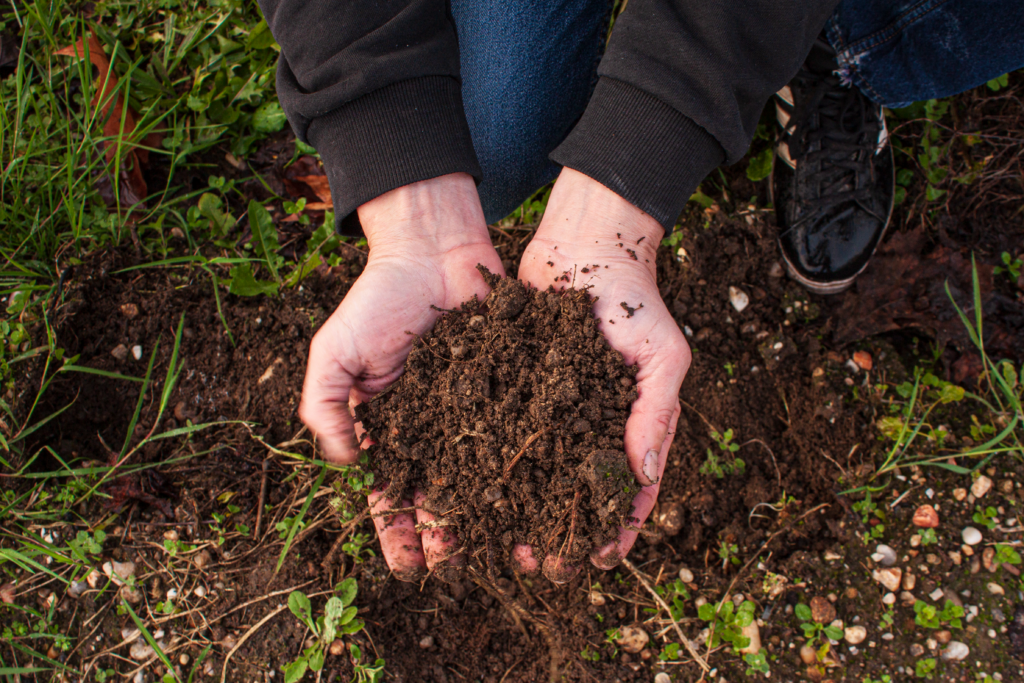
Bordeaux winemakers masterfully blend different grape varieties to achieve complexity, depth, and balance. While several grapes are permitted in the blend, two reign supreme: Cabernet Sauvignon and Merlot. The Left Bank, with its gravelly soils and cooler temperatures, provide an ideal environment for Cabernet Sauvignon, yielding structured, tannic wines with aging potential. The Right Bank, with its clay and limestone soils and slightly warmer climate, is dominated by Merlot, which contributes softness, roundness and plummy, ripe red fruit. I often tell our clients "If theres one thing to take home with you about Bordeaux it's this: Right Bank Merlot, Left Bank Cab. " This difference in terroir—the combination of soil, climate, and topography—is the key to understanding the distinct character of Left and Right Bank wines. The blending of these two primary grapes, along with smaller percentages of Cabernet Franc, Petit Verdot, and Malbec, allows winemakers to craft wines with multifaceted aromas, flavors, and textures, achieving a harmonious balance that is the hallmark of classic Bordeaux. This interplay between grape varieties and terroir is a hallmark of Bordeaux wines. Explore the terroir of Bordeaux on a guided Bordeaux vineyard tour.
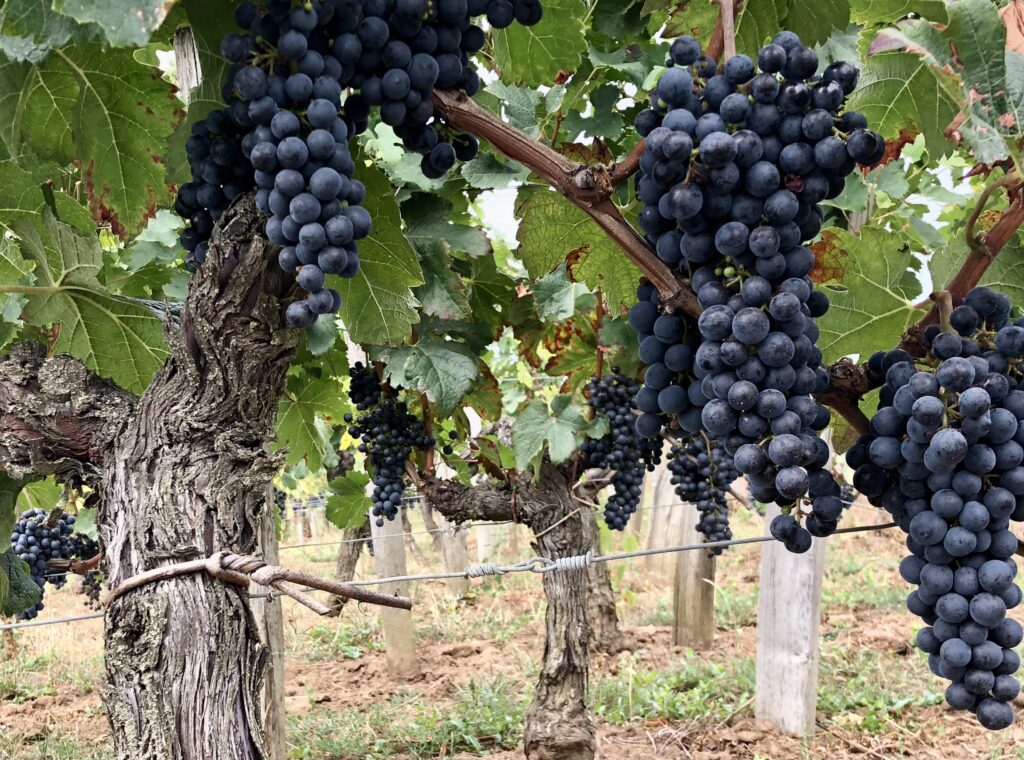
Cabernet Sauvignon is a globally recognized grape variety prized for its robust tannins, full body, and concentrated flavors of dark fruits like blackberry and blackcurrant. While it's a key component of Bordeaux blends, Cabernet Sauvignon is often bottled as a mono-varietal wine in other regions, showcasing its unique characteristics. It thrives in diverse climates, from Bordeaux to Napa Valley. However, the Cabernet Sauvignon grown in Bordeaux's unique terroir, particularly the gravelly soils of the Left Bank, tends to produce wines with even more pronounced tannins than those grown elsewhere. This inherent tannic structure is one of the key reasons why blending is so crucial in Bordeaux winemaking, contributing to the wine's age-worthiness and complexity.
Cabernet Sauvignon's key attributes include its strong tannins, high acidity, and flavors of dark fruits, leather, and spice. These elements contribute to its aging potential and bold, structured profile. While a Bordeaux blend might contain Cabernet Sauvignon, the presence of other grapes, especially Merlot, can soften the tannins and create a more approachable wine. Robust tannins provide a firm backbone, while high acidity keeps the wine vibrant and fresh. The flavor profile is typically dominated by dark fruits like blackberry and blackcurrant, often accompanied by notes of cedar, leather, and spices. These elements combine to create a bold, structured wine that can evolve beautifully in the cellar for decades. In contrast, a Bordeaux blend, while often containing Cabernet Sauvignon, presents a more nuanced picture. The presence of Merlot, particularly in Right Bank blends, can soften the tannins and contribute plumper fruit notes, resulting in a wine that may be approachable earlier than a 100% Cabernet Sauvignon. Even on the Left Bank, where Cabernet Sauvignon is king, the blending with other permitted varietals can modulate the Cabernet's inherent intensity, creating a more complex and balanced wine from its youth, even if it still has aging potential. The final character of a Bordeaux blend depends heavily on the specific proportions of each grape and the terroir of the vineyard. Compare the characteristics of Cabernet Sauvignon and Bordeaux wines on a wine tasting experience.
Understanding the differences between Bordeaux and Cabernet Sauvignon is crucial for any wine enthusiast. Let's delve deeper into their key distinctions.

Bordeaux wines are complex blends, while Cabernet Sauvignon wines are typically mono-varietal. This difference in grape composition significantly impacts the final wine's character. Bordeaux wines are almost always blends, a tradition that dates back centuries. While the exact blend varies depending on the specific appellation and the winemaker's style, the primary grapes used are:
Bordeaux winemakers artfully balance these grape varieties to create wines with complexity, depth, and harmony. The blend allows them to fine-tune the wine's characteristics, adapting to the specific vintage conditions and terroir. Each grape plays a specific role, contributing its unique qualities to the final blend.
In contrast, Cabernet Sauvignon wines are typically made from 100% Cabernet Sauvignon grapes. This allows the grape's inherent characteristics to shine through, showcasing its powerful tannins, full body, and concentrated flavors. While some Cabernet Sauvignon wines may include small percentages of other grapes for blending, the focus remains firmly on the Cabernet Sauvignon grape. This single-varietal expression results in wines with a distinct personality, often characterized by their boldness and intensity.
Bordeaux wines are known for their complexity, elegance, and layered flavors. Cabernet Sauvignon wines are often more intense, structured, and bold, with prominent tannins and dark fruit flavors.
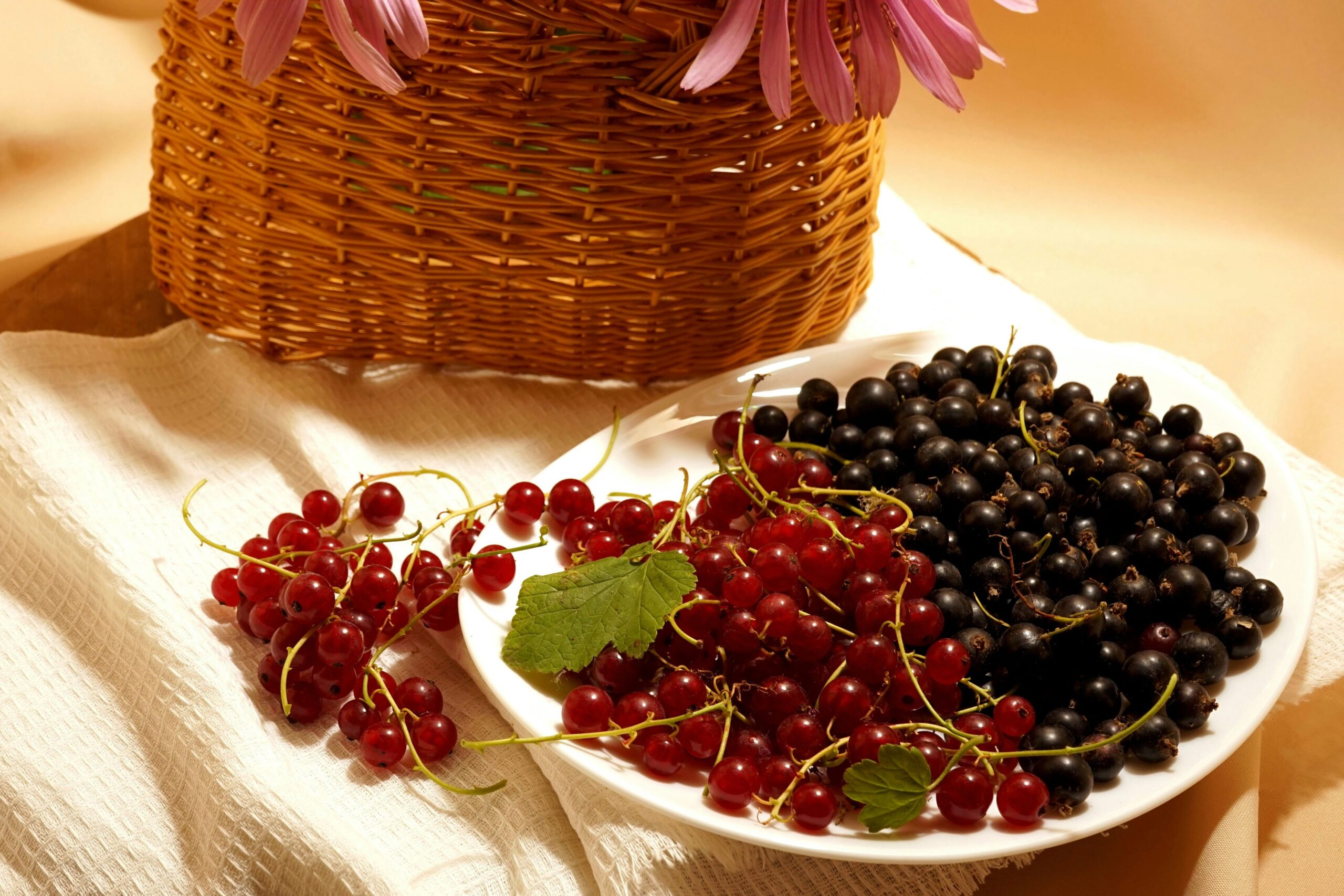
Bordeaux: Due to the blend of grapes, Bordeaux wines offer a complex and layered tasting experience. They often exhibit a wide range of flavors, including:
Bordeaux wines are typically elegant and balanced, with well-integrated tannins and a long finish. The specific flavors and aromas will vary depending on the blend, the vintage, and the sub-region within Bordeaux. For example, Left Bank wines, with their higher proportion of Cabernet Sauvignon, tend to be more structured and tannic, while Right Bank wines, dominated by Merlot, are often softer and more approachable in their youth.
Cabernet Sauvignon: Cabernet Sauvignon wines are known for their intensity, structure, and bold flavors. The dominant flavors often include:
Cabernet Sauvignon wines are typically full-bodied with firm tannins and high acidity, contributing to their aging potential. They are often powerful and concentrated, with a long and lingering finish. While Cabernet Sauvignon wines can be complex, their complexity stems primarily from the Cabernet Sauvignon grape itself, rather than from a blend of different varieties.
Terroir plays a vital role in shaping the differences between Bordeaux and Cabernet Sauvignon. Bordeaux’s maritime climate and diverse soils contrast with regions like Napa Valley, where Cabernet Sauvignon thrives in warmer, drier conditions. These terroir variations influence the flavor, structure, and aging potential of the wines.
Bordeaux's unique terroir, including its maritime climate and diverse soil types, is essential to the region's winemaking success. It contributes to the structure, complexity, and aging potential of Bordeaux wines, making them highly sought after by collectors and enthusiasts.
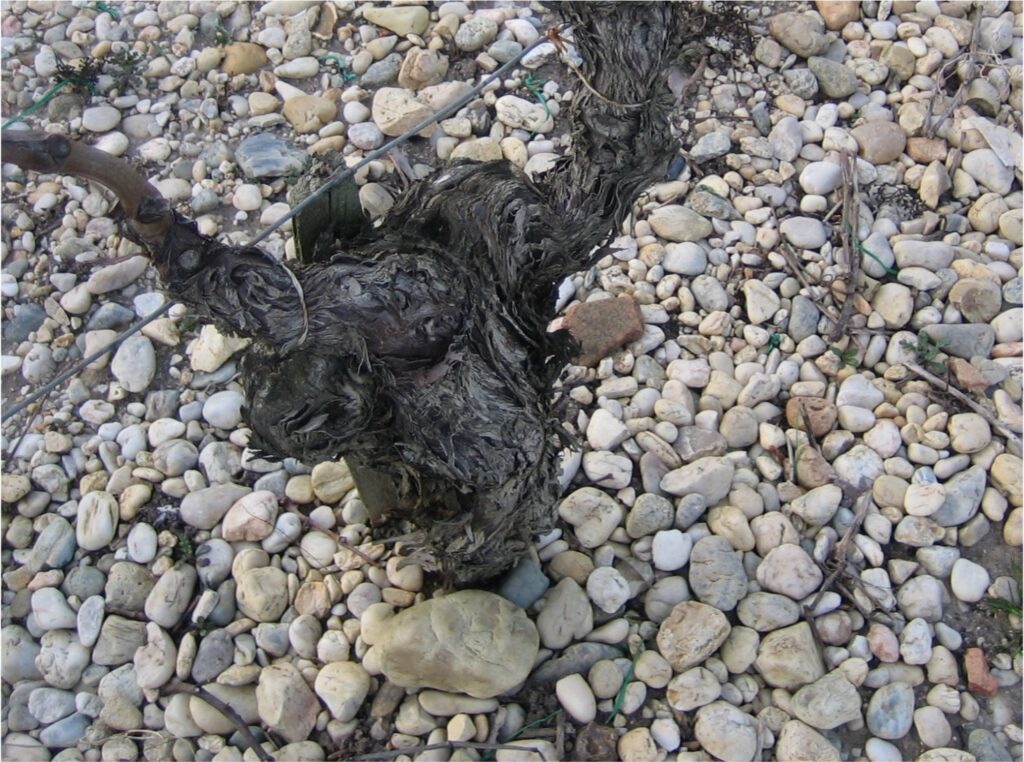
The maritime climate, influenced by the Atlantic Ocean, plays a crucial role. It moderates temperatures, preventing extreme heat spikes and ensuring a relatively long growing season. This allows grapes to ripen slowly and evenly, developing complex flavors and aromas. The ocean also brings humidity and rainfall, which can be both a blessing and a curse. While it provides necessary moisture, it also presents challenges like fungal diseases, requiring skilled vineyard management. The climate's variability from year to year is a key factor in creating vintage variation, adding another layer of complexity to Bordeaux wines. Some years are warmer and drier, leading to riper, more powerful wines, while others are cooler and wetter, resulting in wines with higher acidity and greater aging potential.
The true magic of Bordeaux terroir, however, lies in its diverse soils. The region is essentially a mosaic of different soil types, each contributing unique characteristics to the wines.
The combination of these soil types, often within the same vineyard, allows winemakers to create complex blends that showcase the best of each terroir. The different soil types influence not only the grape varieties that thrive but also the specific characteristics of the resulting wines. For example, Cabernet Sauvignon grown on gravelly soils will have a different character than Cabernet Sauvignon grown on clay soils.
The interplay of climate and soil creates a unique terroir that is impossible to replicate elsewhere. It is this combination that gives Bordeaux wines their distinctive character, their ability to age gracefully for decades, and their remarkable complexity, making them so highly sought after by collectors and wine enthusiasts worldwide.
Explore the unique terroir of Bordeaux with Decanter Tours on a Bordeaux wine tour.
Cabernet Sauvignon expresses itself differently depending on where it's grown. In Bordeaux, the wines tend to be more restrained and balanced, while Napa Valley Cabernet Sauvignons are often more opulent and fruit-forward. These stylistic differences are a direct result of the varying climate and soil conditions. Discover how terroir influences wine on our wine education tours.
Choosing between Bordeaux and Cabernet Sauvignon depends on your personal preferences, the occasion, and what you plan to pair with your wine. Here's a quick guide to help you decide:
Choose Bordeaux if you:
Choose Cabernet Sauvignon if you:
The Best Approach? Explore Both!
Ultimately, the best way to understand the difference between Bordeaux and Cabernet Sauvignon is to taste them side-by-side. Explore different regions, vintages, and producers to discover your own preferences. Both Bordeaux and Cabernet Sauvignon offer unique and rewarding experiences for wine lovers. Don't be afraid to experiment and find what you enjoy most!
Well... A Bordeaux is a wine from the Bordeaux region of France, typically a blend of grapes including Cabernet Sauvignon. Cabernet Sauvignon is a specific grape variety.
Both can age exceptionally well, depending on the vintage and producer. High-quality examples of both can cellar for decades. Since there is Cabernet Sauvignon in a good number of Bordeaux wines it goes to say that Bordeaux ages extremely well.
“Stronger” is subjective. Cabernet Sauvignon can be bolder and more tannic, while Bordeaux offers complexity and elegance. Both can be powerful wines. Thats why we blend.
Ready to explore the world of Bordeaux? Contact Decanter Tours today to book your unforgettable Bordeaux wine tour!
How to Plan a Day Trip to Bordeaux from Paris: Your Ultimate Guide
A day trip to Bordeaux from Paris offers a delightful escape from the bustling city. With high-speed TGV trains connecting the two cities in just under two hours, Bordeaux is an easily accessible destination for a day of wine tasting, cultural exploration, and culinary delights. Whether you're a wine enthusiast or simply seeking a cultural adventure, Bordeaux promises unforgettable experiences. As the heart of France's renowned wine region, Bordeaux boasts world-class vineyards and charming châteaux, inviting visitors to embark on unforgettable wine tours and savor exquisite vintages. Beyond the vineyards, the city itself is a UNESCO World Heritage Site, with its elegant 18th century buildings, vibrant cultural scene, and captivating museums. From exploring the iconic Place de la Bourse to indulging in a gourmet meal at a Michelin-starred restaurant, Bordeaux offers a captivating blend of wine, culture, and culinary delights, making it an ideal getaway for discerning travelers.
A captivating blend of history, wine, and culture, stands as an accessible day trip destination from Paris. This UNESCO World Heritage city boasts elegant 18th and 19th-century architecture, exemplified by the magnificent Place de la Bourse and the grand Saint-André Cathedral, the Tourny Alleys and the Opera Building to name just a few. For wine enthusiasts, the surrounding vineyards offer a world-renowned experience, with opportunities to visit prestigious châteaux like Château Margaux, Palmer, Talbot and Château Lafite Rothschild. Whether you're exploring the city's charming streets, indulging in a gourmet meal, or embarking on a vineyard tour, Bordeaux promises an unforgettable day trip.
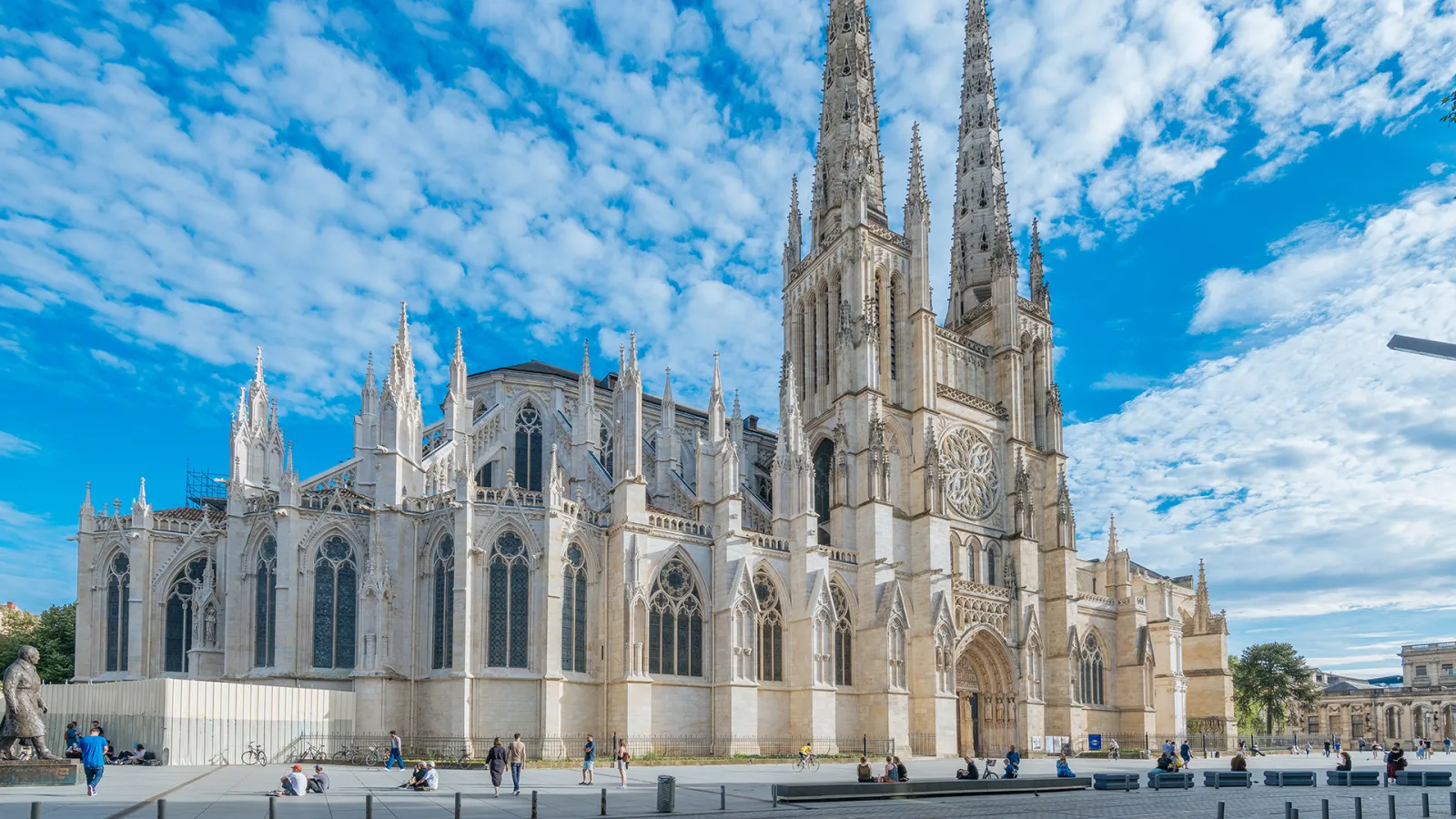
What to Expect from a Private Wine Tour in Bordeaux
A private wine tour in Bordeaux with Decanter Tours offers an exclusive and personalized experience led by expert sommeliers. You'll have the opportunity to visit prestigious wineries, sample some of the world's finest wines, and gain insights into the mysterious world of Bordeaux wines. Decanter Tours provides tailored itineraries, allowing you to explore the region's most renowned appellations at your own pace. You have the choice of wine regions to discover such as Bordeaux, Saint-Émilion, Graves, Sauternes, Cognac and the Médoc.
Indulge in the ultimate luxury with a private wine tour curated just for you. From vertical tastings in historic cellars to food pairing lunches and vineyard visits with breathtaking views, your bespoke experience will be tailored to your specific interests and preferences. Our expert Master Sommelier guides will lead you through the world of Bordeaux wine, sharing their expertise and passion, whether you're a seasoned connoisseur or a curious novice.
The most convenient way to reach Bordeaux from Paris is by TGV high-speed train, offering a scenic journey of approximately two hours. For those seeking flexibility, car rental is an option. While it is possible to use a connecting flight upon your arrival in France, if you stay over in Paris first, you will have to take another form of transportation. Domestic flights from Paris to Bordeaux are not readily available. With the French governments stance on sustainability and lowering our carbon footprint, they acted on short haul flights. Compared to driving the same distance, taking the train saves about 87% carbon emissions per passenger. According to google travel site.
The most convenient way to reach Bordeaux from Paris is by TGV high-speed train, offering a scenic journey of approximately two hours. This efficient mode of transportation allows you to maximize your time in Bordeaux, minimizing travel time and maximizing your exploration.
To book your TGV tickets, visit the SNCF Connect website or app . Be sure to check the train schedule in advance, as it may vary depending on the day and time. Consider booking your tickets in advance, especially during peak seasons, to secure your preferred departure time and potentially benefit from early-bird discounts.
The TGV offers a comfortable and enjoyable travel experience, with spacious seating, ample legroom, and onboard amenities such as Wi-Fi and food services. By opting for a TGV, you can relax and unwind during your journey, arriving in Bordeaux refreshed and ready to explore. Dont forget you will have to carry your own luggage. There are few elevators in French stations so pack light if you plan to use the train.
For those seeking a more flexible and leisurely journey, renting a car offers a great way to explore the French countryside and reach Bordeaux at your own pace. The drive from Paris to Bordeaux can be a scenic adventure, with opportunities to stop at charming villages, local bistrots and vineyards along the way.
Scenic Stops:
Parking in Bordeaux: While parking in Bordeaux can be challenging, especially in the city center, there are several options available. Consider using public parking garages or seeking out designated parking areas near the tourist attractions you plan to visit.
A Word of Caution: It's important to remember that drinking and driving is dangerous. If you plan on wine tasting during your trip, this should be taken into consideration. Additionally, be mindful of speed limits and traffic laws, as French roads are heavily monitored by speed cameras, some hidden and some not so.
By choosing to drive, you have the freedom to customize your itinerary, explore hidden gems, and indulge in spontaneous detours.
Top Things to See in Bordeaux on a Day Trip
Bordeaux, a UNESCO World Heritage Site since 2007, offers a wealth of cultural and historical attractions that can be easily explored in a day trip. The city’s iconic Place de la Bourse, with its stunning water mirror, is a must-see. The magnificent Saint-André Cathedral, a masterpiece of Gothic architecture, is another highlight. To immerse yourself in the city's history and charming atmosphere, explore the historic neighborhoods of Saint-Pierre and Chartrons.
The Place de la Bourse, a masterpiece of 18th-century architecture, is one of Bordeaux's most iconic landmarks. Its elegant facades and harmonious proportions create a striking visual impact. At its center lies the Miroir d'Eau, a vast reflecting pool that creates a mesmerizing optical illusion, reflecting the surrounding buildings and sky. This modern addition to the historic square has transformed it into a popular gathering place for locals and tourists alike.
To truly understand Bordeaux's rich history and wine culture, it's worth exploring the historic districts of Saint-Pierre and Chartrons. These neighborhoods, once bustling centers of the city's wine trade, are now charming and vibrant areas to wander through. Most of the merchant buildings have been converted to restaurants and small boutiques. The architecture of Chartrons reflects its diverse past, with influences from Bordeaux's maritime and colonial history.
After a day of wine tasting, take a leisurely stroll through the quaint streets, admiring the beautiful buildings and stopping at charming cafés for a coffee or a glass of wine.
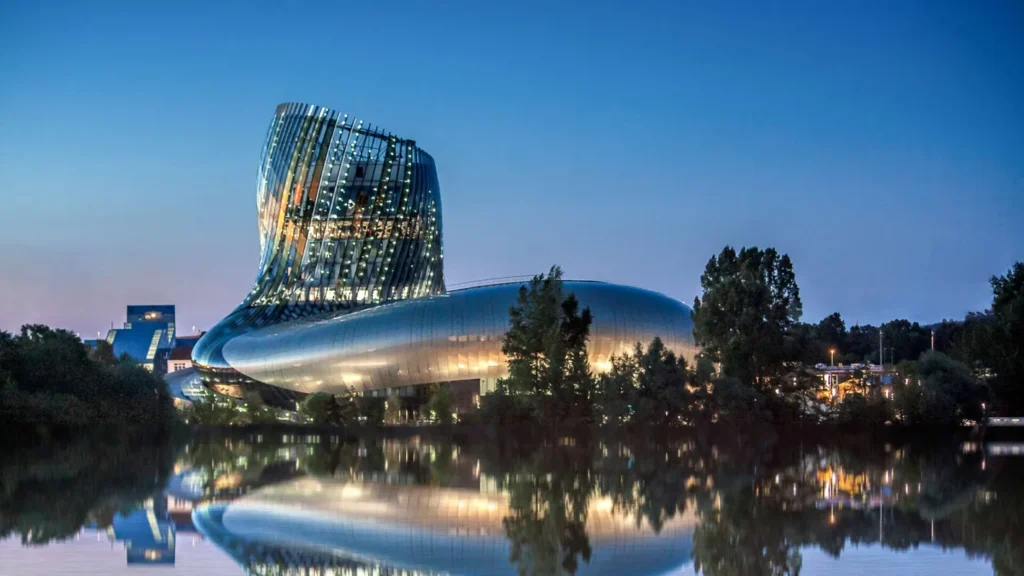
To delve deeper into Bordeaux's rich cultural heritage, consider visiting some of its renowned museums. For wine enthusiasts, the Cité du Vin offers an immersive experience, exploring the history and culture of wine. Art lovers will appreciate the Musée des Beaux-Arts, which houses a vast collection of paintings, sculptures, and decorative arts. For a unique and visually stunning experience, visit the Bassins de Lumières, where digital art projections transform the historic docks into a mesmerizing spectacle.
For those interested in decorative arts, the Musée des Arts Décoratifs and Design, housed in a charming 18th-century mansion, offers a fascinating collection of furniture, ceramics, and textiles. This museum provides a glimpse into the elegant lifestyle of Bordeaux's past.
To explore the broader history of Aquitaine, the Musée d'Aquitaine is a must-visit. This comprehensive museum showcases the region's past, from prehistoric times to the present day. You can discover archaeological artifacts, historical documents, and interactive exhibits that bring the history of Aquitaine to life.
For the discerning wine enthusiast, a private tour is undoubtedly the most rewarding way to experience Bordeaux's renowned vineyards. Unlike larger group tours where you are thrown in with strangers, private experiences offer unparalleled flexibility and personalization. You'll enjoy exclusive access to prestigious domaines, often unavailable to the general public, and indulge in intimate tastings led by passionate winemakers. From exploring lesser-known appellations to savoring rare vintages, your itinerary can be tailored to your specific interests and pace. With a private driver at your disposal, you'll enjoy the freedom to linger at your favorite spots, have time for a leisurely lunch at a charming vineyard restaurant creating a truly unforgettable Bordeaux adventure.
Indulge in a truly bespoke Bordeaux experience with Decanter Tours. Our private wine tours are meticulously crafted to your desires, offering access to prestigious domaines like Château Margaux, Château Lafite Rothschild, and Château Cheval Blanc. Imagine a day curated around your passions, whether it's exploring the intricacies of Médoc blends, discovering the elegance of Saint-Émilion, or delving into the world of organic and biodynamic viticulture. Our expert guides will ensure an unforgettable journey, providing insightful commentary, arranging exclusive tastings, and even securing private vineyard walks. As one recent guest shared, 'Decanter Tours exceeded all expectations. The personalized itinerary, knowledgeable guide, and access to exceptional wines made for an unforgettable day.' Trust Decanter Tours to orchestrate a Bordeaux wine adventure that will linger in your memory long after you've returned home.
For a truly memorable lunch, indulge in Bordeaux's culinary delights. Savour regional specialties like succulent magret de canard (duck breast) and delicate canelés (rum and vanilla pastries) at top-rated establishments. We highly recommend Les Belles Perdrix in Saint-Émilion, renowned for its refined cuisine and charming ambiance. In Margaux, Au Marquis offers a delightful taste of Bordeaux heritage with its classic French dishes. For a more intimate and elegant setting, enjoy a light lunch at the charming Château Marquis d'Alesme. And in the Graves region, La Table du Lavoir at les Sources de Caudalie provides a charming setting for a memorable meal.
The high-speed TGV train journey from Paris Montparnasse to Bordeaux Saint-Jean typically takes around 2 hours and 10 minutes. This makes Bordeaux easily accessible for a day trip from the French capital.
Yes, you can certainly visit Bordeaux in one day from Paris. While a full immersion requires more time, a well-planned day trip allows you to either experience the city's highlights, focusing on key attractions like the Place de la Bourse, the Saint-André Cathedral, and the charming Saint-Pierre district, or dive quickly into the vineyards for a private wine tour in either the Médoc, Graves or St Emilion wine regions.
Absolutely! A private wine tour is an excellent option for a day trip to Bordeaux. With a customized itinerary and a dedicated driver, you can efficiently visit several prestigious vineyards and enjoy a personalized wine tasting experience. This flexibility allows you to make the most of your time and create a memorable day trip.
Saint-Émilion is not far from Bordeaux center. It is easily accessible by train from the main station Gare Saint Jean. The journey costs around 10€ ($10.50) and takes about 60 minutes. There are also taxis and Uber is available but they can cost anywhere from 50 - 100€ one way. So lets say you decided to take the train into Saint-Émilion. You arrive at the base of the hill and its a short 30 minute brisk walk uphill to the edge of town. Once in town you'll find lots of cafés, restaurants and of course wine shops. The tourist office offers guided tours of the underground monuments which can be reserved on the day. But be careful, in high season they fill up quickly. Its easy enough to get around the town by foot. There are even one or two vineyards you can visit by foot from the center of town. These however are best reserved well in advance. The majority of the Chateau around Saint-Émilion are only accessible by car however.
The town founded in the 8th century boast many buildings and the ramparts circle the village. There is a kings tower and a dungeon which can all be visited.
Saint-Émilion, a UNESCO World Heritage site, is a captivating destination that blends history, culture, and breathtaking natural beauty. Its historic center boasts winding cobblestone streets and medieval architecture. Legend has it that Saint-Émilion himself, a hermit, carved out his hermitage in the soft limestone cliffs of the region. A visit to the caves is a must for everyone. For wine enthusiasts, the region's iconic vineyards produce world-class wines. Beyond wine, immerse yourself in the region's cultural heritage, visit local art galleries, and enjoy the peaceful countryside and sit in a garden and discover the local Crémant de Bordeaux sparkling wine produced in the caves below the town. Discover the magic of Saint-Émilion and create unforgettable memories
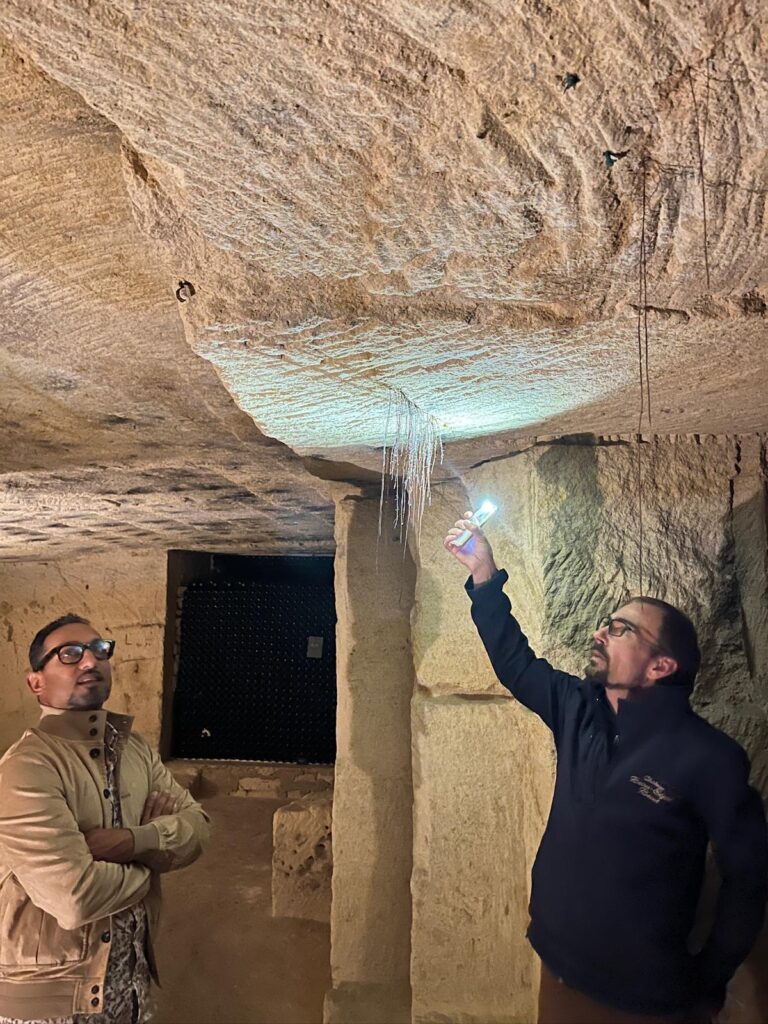
Saint-Émilion's wines are renowned worldwide for their exceptional quality and unique character. A key factor contributing to their distinctiveness is the region's unique terroir. The town is built on limestone hills covered with clay. The limestone-rich soils of Saint-Émilion play a crucial role in shaping the wines, imparting minerality and structure. In the whole of the Bordeaux wine region we tend to blend our wines and Saint-Émilion is no exception. The two predominate grape varieties grown here are merlot and cabernet franc.
Traditional Vinification Methods: Saint-Émilion winemakers adhere to traditional vinification methods, which involve careful grape selection, gentle pressing, and long aging periods in oak barrels. These techniques help to develop the wines' complex flavors and smooth tannins. Ageing can be anywhere from 6 - 24 months depending on the vintners taste.
Distinction from Other Bordeaux Appellations: Saint-Émilion wines stand out from other Bordeaux appellations due to their distinctive terroir, grape varieties, and winemaking styles. While the Left Bank of Bordeaux is dominated by Cabernet Sauvignon-based wines, Saint-Émilion's Merlot-dominant blends offer a softer, more approachable style. They are wines to be drunk young (5 - 15 years) thanks to the predominance of Merlot.
The Prestigious Classification of Saint-Émilion Wines: The Saint-Émilion wine classification started almost 100 years after the prestigeous 1855 Classification of the Medoc and Graves. It is a rigorous system that ranks the region's chateaux based on the quality of their wines. The classification is revised every 10 years, ensuring that it reflects the current quality hierarchy. There can be some confusion about about the wording on the bottles and what they mean. The following may help.
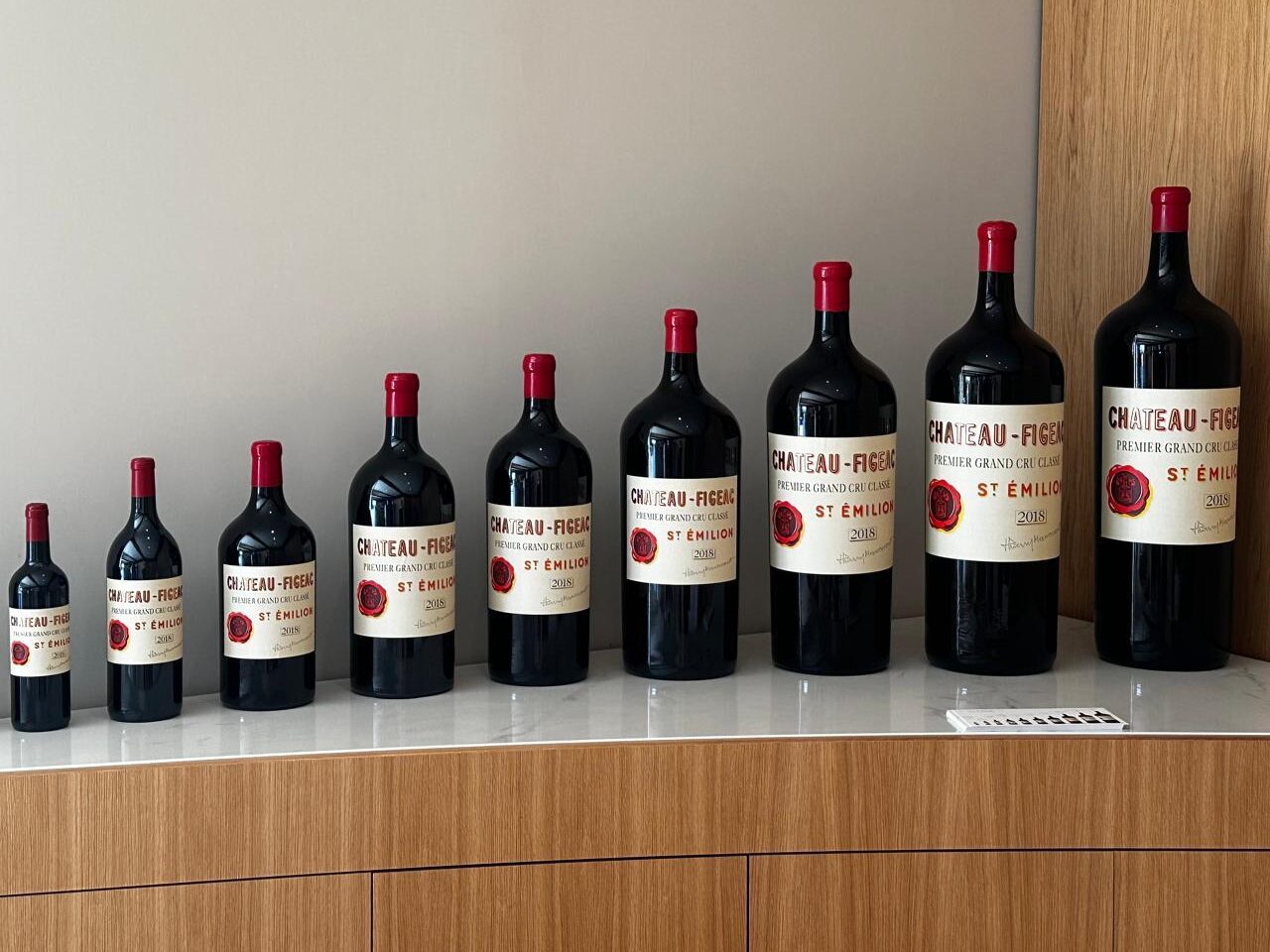
By understanding the unique terroir, grape varieties, and winemaking techniques of Saint-Émilion, wine enthusiasts can appreciate the complexity and elegance of these exceptional wines.
The proximity of Saint-Émilion makes it an ideal location for a day trip from Bordeaux. Saint Emilion is 40 kilometers or about 25 miles from the center of Bordeaux. It is an easy short 45 - 50 minute journey by car. By train, from the Gare Saint Jean train station the journey takes about an hour. For the budget conscious, there are few local busses that can take you to Saint-Émilion but they take over an hour and have many stops along the way. Ideally it is best time to go to Saint-Émilion from Bordeaux outside the major rush hours of 8:30-9:30 AM and 4:30 - 6:30 PM. These times can be very busy and leaving Bordeaux within these hours will eat into your wine tasting time.
When planning your trip to Saint-Émilion, consider these transportation options to make the most of your experience:
Taking a bus to Saint-Émilion is affordable but it is not an easy task. You can buy tickets directly on the TBM (Transports Bordeaux Metropole) app. Routes and schedules are also available there.
Booking tickets are easy via the SNCF website or you can buy tickets from the machines in the train station. The machines take all major credit cards and cash and they offer English translation making the whole process very simple. Trains run every hour throughout the day.
Cycling to Saint-Émilion from Bordeaux is a fantastic way to see the French countryside up close. There is a cycle path which cuts through rolling hills and vineyards, quaint local towns and vast fields. The 4 hour journey by bike is definitely rewarding. Of course electric bikes are available also and can easily be rented. There are a few companies who organize direct rentals in the area. One way collection fees will be imposed should you not cycle back to your starting point.
Driving yourself can be fun but does not come without its challenges. Renting a car in Bordeaux is one option, either at the train station or at the Bordeaux airport. Driving in Europe can be daunting for some but really its not that different. Parking is the most complicated. Knowing when to pay and when your are in a taxi stand can be confusing.
Our expert guides will enhance your experience in the heart of this prestigious wine region, providing insider knowledge and exclusive access to some of the most renowned vineyards in Saint-Emilion. Whether you're a seasoned wine connoisseur or a curious newcomer, our personalized tours are designed to cater to your interests and preferences. Decanter Tours' guided tours provide insider knowledge, exclusive access to vineyards, and a personalized experience, making them ideal for both wine connoisseurs and casual enthusiasts.
Description: Describe a typical wine tour, including visits to prestigious wineries, private vineyard access, tastings, and behind-the-scenes experiences in wine production. Highlight the personalized nature of the tours led by expert sommeliers, catering to both beginner and experienced wine lovers.
A typical Saint-Émilion wine tour with Decanter Tours includes:
Description: Promote specific tours offered by Decanter Tour, such as luxury private tours or small group excursions. Highlight the unique features of these tours, like tailored itineraries, VIP access, and transportation options..
Decanter Tour offers a variety of wine tours to Saint-Émilion, tailored to suit different tastes and budgets. Combine Saint Emilion with Fronsac or Pomerol and throw in a winemakers' lunch. Or just concentrate on a Saint Emilion wine tour with either 2 or 3 wineries visited in a day. All our tours have the following advantages:
While Saint-Émilion is undoubtedly renowned for its world-class wines, the region offers a wealth of cultural and historical attractions that make it a truly captivating destination.
A Glimpse into the Past:
Saint-Émilion offers a unique blend of natural beauty, cultural heritage, and culinary delights. Whether you're a wine enthusiast, a history buff, or simply seeking a relaxing getaway, this enchanting region has something for everyone.
To experience the best of Saint-Émilion, consider booking a guided wine tour with Decanter Tours. Our expert team will curate a personalized itinerary, ensuring you have a memorable experience.
Immediate Online Booking is Available Or let us curate your tour in Bordeaux with your input. Click below for more information.
By Train it takes one hour. By car 45 mins to an hour depending on traffic. By bike it takes 3 - 4 hours depending on your pedal speed.
By far yes! There are no problems with drinking and driving. You will be dropped off and accompanied in the center of town so no problems with parking. And when you take one of Decanter Tours' guided wine tours the learning curve is enormous. Our guides are all trained in wine with either an Master of Wine, the WSET diploma or the local Bordeaux oenology faculty's DUAD qualification.
Yes you certainly can. Its an easy trip and the perfect day out when you visit Bordeaux.
Wine lovers tend to get obsessed with Bordeaux, the world’s capital of wine, and its renowned wine-producing regions: the Médoc, Graves and Sauternes, Blaye and Bourg, Saint-Emilion, Pomerol and Fronsac, and Entre-Deux-Mers. In fact, many believe the region is solely about wine, like there’s nothing else to see or do beyond Bordeaux.
We love wine as much as the next geek, but if you believe Bordeaux is solely about wine, then you’re in for a pleasant surprise. Located in the Gironde department, Nouvelle-Aquitaine region, in southwestern France, Bordeaux is a stone’s throw away from some exquisite destinations that feed the soul–for their breathtaking beauty–and feed the belly, bien sûr! Offering everything from exquisite gastronomy, rich history, stunning natural beauty, sunny beaches, and yes, more wine but a wide array, including distilled wines, Bordeaux is surrounded by a variety of attractions that cater to just about everyone, appealing to all tastes.
If you’re planning a day trip (or two!) from Bordeaux, here are some excursions for things to see and do:
Arcachon Bay, known as "Bassin d'Arcachon" in French, located on the Atlantic coast about 30 miles (50 kilometers) southwest of Bordeaux, is a stunning natural site renowned for its diverse landscapes, vibrant wildlife, and oysters! There’s so much to see and do (and eat!), making it the perfect spot for beach bums and gourmands.
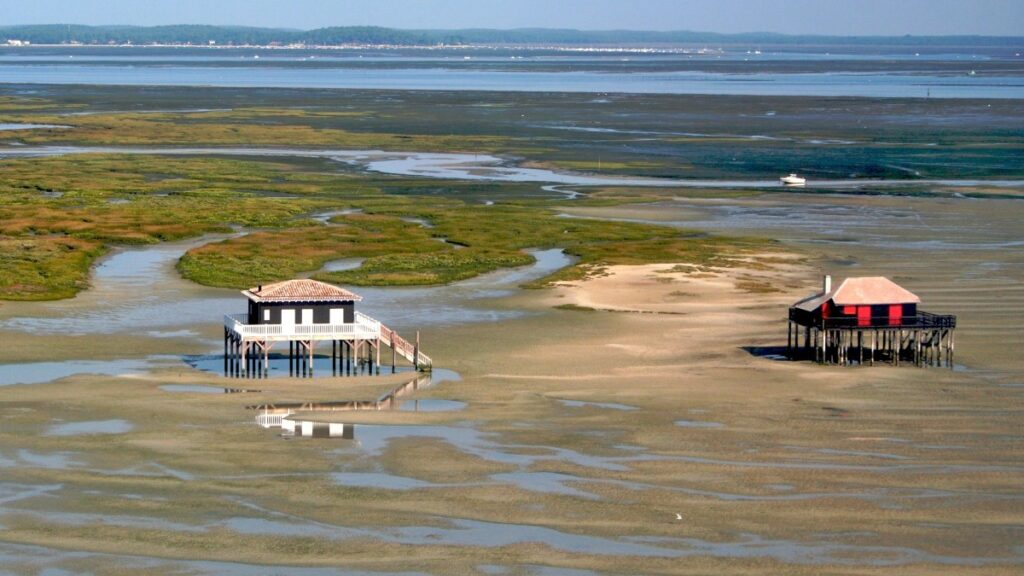
Most famous for the Dune of Pilat, Europe’s highest sand dunes, reaching over 100 meters in height, visitors can climb the dune to take in the breathtaking scenery and panoramic views of the bay, the Atlantic Ocean, and the surrounding pine forests.
The Île aux Oiseaux (Bird Island), a small island in the middle of the bay, is famous for its stilted wooden cabins, known as "Cabanes tchanquées," and is a haven for birdwatchers, with a variety of bird species nesting in the area.
All this landscape certainly makes one hungry and there’s nothing better than stopping at one of the many traditional huts to eat fresh oysters. Considered a delicacy and a significant part of the region's culture and economy, visitors can tour oyster farms and taste fresh oysters in the local markets and restaurants.
And of course, there’s Cap Ferret. The Cap is the setting for the hit movies Les Petits Mouchoirs (Little White Lies) and then its sequel, Nous Finirons Ensemble (We’ll End Up Together), two films that show just how important Cap Ferret is for the French psyche, particularly the Parisians. Facing Arcachon, Cap Ferret is more local, more laid back, with plenty of small seaside towns along the peninsula. Don’t forget to visit the Cap Ferret Lighthouse for panoramic views.
The maritime city of La Rochelle, just a two-hour drive north of Bordeaux, is a picturesque port town located on the Atlantic coast. Steeped in history that stretches back to antiquity, La Rochelle flourished during the Middle Ages and Renaissance, becoming one of France's most significant maritime centers.
Over the centuries, La Rochelle has retained its seafaring heritage and importance. The city's historic harbor is famously guarded by its iconic towers—the Tour de la Chaîne and Tour Saint-Nicolas—standing as proud reminders of its fortified past. These remarkable structures not only protected the port but also symbolize the city's enduring maritime legacy.
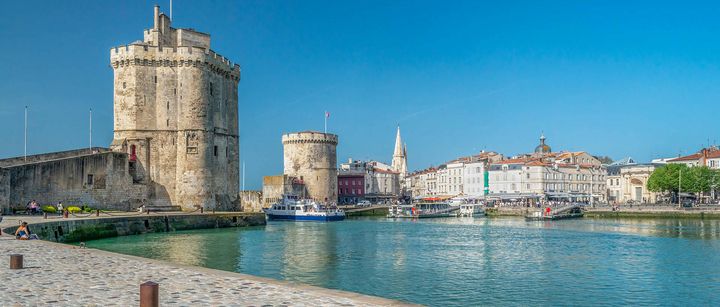
La Rochelle offers a delightful blend of history and modern attractions. Visitors can wander through the Old Port ("Vieux Port"), lined with bustling cafés, seafood restaurants, and sailboats, capturing the quintessential charm of this coastal gem.
A must-see is the renowned La Rochelle Aquarium, one of the largest in Europe, where you can explore the wonders of the ocean and discover a mesmerizing array of marine life.
One hour’s drive north from Bordeaux, Cognac is a charming medieval town renowned worldwide for its production of the luxurious brandy also called Cognac. It lies along the Charente River, and is home to some of the most prestigious Cognac houses in the world, including Hennessy, Martell, Rémy Martin, Courvoisier, and Camus, to name just a few. The small town regularly receives VIP visitors, such as Alicia Keys or Lebron James just this week! These legendary maisons (houses) have been producing Cognac for generations, each with its own unique techniques and closely guarded secrets that contribute to the distinct flavors and quality that have made Cognac a symbol of luxury and sophistication worldwide.
Visitors to Cognac have the opportunity to explore these grand houses, many of which offer guided tours that delve into the fascinating process of Cognac production, from grape harvesting and distillation to aging in oak barrels. These tours often conclude with tastings, allowing guests to savor some of the finest and most sought-after Cognacs, ranging from VS (Very Special) to the coveted XO (Extra Old) varieties.
Northwest of Bordeaux lies the Dordogne region. With its deep historical legacy, from prehistoric times to the medieval period, marked by the Hundred Years' War between England and France, the region is dotted with châteaux, fortified towns, and charming medieval villages. A quick train ride from Bordeaux’s Gare Saint Jean train station will take adventurous visitors to the delightful towns of Sarlat-la-Canéda, Beynac-et-Cazenac, or Castelnaud-la-Chapelle.
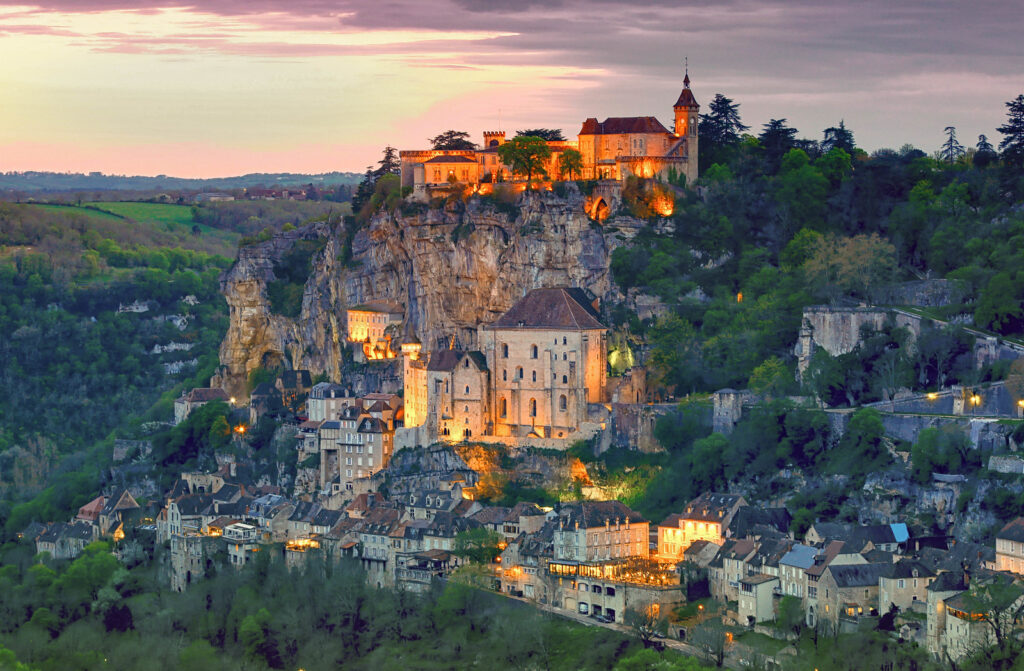
Also known for its rich gastronomic traditions, bustling village markets offer visitors a chance to experience the region’s delicious culinary heritage, such as foie gras, truffles, walnuts, and cheeses.
For nature lovers, the Dordogne offers breathtakingly beautiful landscapes. The Dordogne River winds its way through the region, carving out a valley that offers some of the most picturesque scenery in France. The river is bordered by steep limestone cliffs, rolling green hills, and villages perched high above the water. The Vézère Valley, a UNESCO World Heritage site, is particularly famous for its prehistoric sites and striking rock formations, with caves such as Lascaux and Font-de-Gaume nestled within this remarkable landscape.
The French Basque Country south of Bordeaux offers an extraordinary mix of coastal beauty, charming villages, rolling hills, and a vibrant, deeply rooted culture. Whether you're strolling along the elegant beaches of Biarritz, sampling pintxos in Saint-Jean-de-Luz, hiking the lush mountain trails, or immersing yourself in traditional Basque music and sports, this region is a captivating destination that offers a unique and unforgettable experience.

Curious to include these day excursions into a comprehensive Bordeaux wine tour? Take a look at our "Bordeaux in 4 Days with hotel" tour or get in touch to create a tailor-made tour just for you!

So you want to come to Bordeaux. And because you’re a wine lover, you’re thinking of hitting up a few wineries in the Medoc, Saint Emilion, and why not, Sauternes. You’ve got a few minutes to kill and head over to ChatGPT. At the touch of a button, you’ve got your trip planned out.
In an era where technology permeates every part of our lives, it's no surprise then that Artificial Intelligence (AI) platforms for travel planning have entered the equation. Fast, free and full of promise, these platforms are able to spit out a wealth of options for your next dream vacation.
We love technology as much as the next person–after all, it has made travel much easier and accessible to all–but we were curious to try some of these platforms ourselves, wondering if it was time to close our office. On one of the most widely-used travel platforms, we entered our prompt:
“My wife and I will be in Bordeaux on September 7 and 8th. We would like to arrange a guided tour with a driver/guide to visit the left bank on one day and the right bank on another. Can you please suggest an itinerary for these days. We love and enjoy the top first and second growths but understand that they are often not available or are visited at a premium.”
In a matter of nanoseconds, our wine tours were ready. Our bot was friendly, efficient and created an itinerary that would’ve made Robert Parker jealous. Margaux, Latour, Figeac, Angelus, Cheval Blanc, it seemed that nothing was out of bound, as if all these properties were available even during one of the busiest times of the year: harvest. It was, dare we say, too good to be true.
As Bordeaux travel experts, with more than 20 years experience, we know better. Amidst all the convenience that AI provides, it's imperative to recognize its limitations, and understand the indispensable value of a human touch. Particularly in the domain of wine tours in France, the limitiations are immense. Sure AI platforms can suggest the top properties, but actually securing a spot in one of these esteemed venues is a feat which often requires tact, persuasion and years of relationship-building. None of which the AI bots are equipped to handle.
Several AI itinerary planning platforms have gained prominence in recent years, revolutionising the way we plan and experience travel. Platforms such as Copilot2trip, Google Trips, Guide Geek, Expedia, and Curiosio are able to pull data from all corners of the internet and provide customized itineraries. With impressive features and functionalities, from AI-powered travel advisors, fully integrated comprehensive booking systems, real-time recommendations, and travel experiences tailored to your personal preferences and interests, we’ve got to hand it to Silicon Valley, it’s a job well-done.
Yet, even with all this sophistication and high-tech, in wine regions like Bordeaux, where the slower life, traditional country values and local customs dictate the rules of the game, relying on AI platforms for your travel plans can lead to massive disappointments.
AI chatbots like ChatGPT, while capable of providing basic travel assistance, lack the nuanced understanding and real-world experience required for complex itinerary planning and booking.
To go back to our “conversation” (if we can even call it that) with our bot, the options didn’t take into consideration that September 7th and 8th fall on a weekend, when all (save Yquem) of the Bordeaux First Growths are closed. And it’s not just a lack of information from the sources where AI is getting its data, not all First Growths are open to the public, and many filter the visitors they receive with an initial screening.
Beyond the famous chateau, the smaller, boutique wineries aren't always on top of their game, often burdened by the day to day of running a winery. Scheduling visits then requires numerous follow up emails, calls and coordination. We don’t want to brag, but what we do is practically an art form. Jokes aside, the reality is that AI has massive blind spots, including:
We’ll all bite the dust eventually but when it comes to booking your wine tours, partnering with a reputable agency like Decanter Tours, with over 20 years of experience in the field of wine tours, offers distinct advantages:
The proof is in the pudding: our customer reviews continuously highlight these points, which you can read here. Perhaps the most important point is that our personalized attention builds trust, an intangible attribute that is so very important in tourism.
All this to say, we’re not closing our office just yet. Yes, AI platforms have revolutionized the way we plan and book travel, but they cannot replace the value of human expertise, personalized service, and insider connections offered by reputable wine tour agencies like Decanter Tours.
We believe that by combining the efficiency of AI with the human touch of experienced professionals, travelers can enjoy the best of both worlds—a seamless planning process and unforgettable experiences that exceed their expectations. Now, which Medoc First Growth chateau was it that you wanted to visit? Contact us to talk about it... in person!
Nestled in the southwest of France, the Médoc region is home to some of the world’s most famous and prestigious chateaux, making it a bucket-list destination for wine lovers. Located on the legendary “Left Bank” of Bordeaux, the Médoc is renowned for its high-quality red wines, crafted primarily from Cabernet Sauvignon, Merlot, and Cabernet Franc grapes. Stretching roughly 50 miles from Bordeaux, and bordered by the Atlantic Ocean on one side and the Gironde estuary on the other, the Médoc provides a scenic backdrop for your wine-tasting adventure.
For those seeking an authentic Bordeaux wine experience, visiting a Medoc Chateau is a must. Whether you’re sampling bold, structured reds or touring historic wine estates, this region offers an immersive insight into centuries-old wine traditions. The Médoc's rich viticultural history and status as a key player in Bordeaux's wine industry make it a perfect destination for both casual tourists and serious oenophiles. With a variety of chateaux ranging from small, family-run wineries to grand estates like Château Margaux and Château Latour, the Médoc offers something for every type of visitor.
The Médoc region is divided into several distinct areas or appellations: Haut-Médoc and Médoc being the two regional appellations. In fact the Medoc appellation was once called Bas-Médoc but that term was thrown out being slightly derogatory. (Bas means lower) The others are communal appellations or named after the towns they encompas. Margaux, Pauillac, Saint-Julien, Saint Estephe, Listrac-Medoc and Moulis en Medoc. The whole peninsula is called Médoc wine region. All of the appellations boast impressive Médoc chateaux and world-class wines, but they offer slightly different experiences for wine tourists.
The southern portion of the Médoc peninsula, is home to some of the most prestigious wine appellations in Bordeaux.
These include world-famous appellations such as :
- Margaux
- Pauillac
- Saint-Julien
- and Saint-Estèphe
Each commune produces wines that are celebrated for their complexity, structure, and ageing potential. Visiting a Médoc chateau offers the opportunity to explore legendary estates and taste wines that frequently feature in international auctions. Iconic names like Château Mouton Rothschild and Château Margaux are part of this distinguished region, making the Médoc a magnet for serious wine enthusiasts.
In contrast, the Médoc appelation, located in the northern part of the region, offers a more relaxed and intimate wine-tasting experience. While it may not have as many classified growths, the Médoc is home to charming, family-run wineries and smaller estates that produce excellent wines with great value. A visit to a Médoc appellation chateau often includes personal, guided tours where winemakers share their passion for viticulture. The wines from Médoc tend to be more fruit-forward being predominately Merlot grapes and approachable, providing a different yet equally rewarding experience of the Médoc terroir.
Whether you choose to explore the prestigious estates of southern Medoc area or the hidden gems of the Medoc appellation, both regions offer rich history, beautiful landscapes, and, of course, extraordinary wines that will make your private Medoc wine tour unforgettable.
Medoc chateaux are not only revered for the exceptional wines they produce but also for their historical significance and unique terroir. Many of the most renowned estates were ranked in the 1855 Bordeaux Official Wine Classification, which still holds considerable influence today. Legendary names like Château Mouton Rothschild, Château Margaux, and Château Latour are recognized worldwide, attracting wine enthusiasts eager to experience the heritage behind these iconic labels.
What truly sets Medoc chateaux apart is their ability to craft wines that reflect the unique characteristics of the Médoc region. The area’s gravelly soils, coupled with the moderating influence of the Gironde estuary, create ideal conditions for producing robust, long-lived red wines dominated by Cabernet Sauvignon. Visitors to these chateaux not only get the chance to taste world-class wines but also witness the meticulous processes behind their production—from vineyard management to cellar aging.
Beyond the wines, the Medoc chateaux experience is a cultural journey. Many estates feature stunning 17th and 18th-century architecture, sprawling vineyards, and centuries-old family legacies. Whether it’s a small, family-run estate or one of the prestigious Classified Growth Chateaux, visiting a Medoc chateau allows you to dive deep into the region’s viticultural heritage and craftsmanship that have defined Bordeaux wine for generations.
Timing your visit to a Medoc Chateau can greatly enhance your private Medoc wine tour experience, as each season brings something different to the table. From the vibrant energy of the harvest in autumn to the peaceful quiet of winter, each time of year offers unique opportunities for visitors.
No matter the season, our detailed guide will help you choose the perfect time to explore the Medoc region’s famous chateaux and immerse yourself in Bordeaux's wine culture.
Autumn in the Medoc region is a dynamic and captivating time, as vineyards are busy with the annual grape harvest. From September to November, winemakers are hard at work, gathering grapes and preparing for vinification. This is the best time to visit a Medoc Chateau if you want to experience the behind-the-scenes excitement of Bordeaux winemaking.
September is especially busy, as many of the famous chateaux, such as Château Margaux and Château Latour, are deeply engaged in harvest activities. With all hands on deck, larger estates may limit public access or reduce the number of tours available. Advance booking—6 to 9 months beforehand for the most popular chateaux—is crucial during this high-demand period. October sees the tail end of the harvest, with more opportunities for visitors to get a glimpse of the process without the heavy crowds.
By November, things start to quiet down as the tourist season winds down, but it’s still possible to visit many chateaux, especially smaller, family-run estates. The changing autumn colors across the vineyards also offer a picturesque backdrop, making this one of the most visually stunning times of the year to visit a Medoc Chateau.
Winter in the Medoc wine region offers a more peaceful, intimate experience compared to the busier seasons. While the vineyards are dormant and the harvest has long passed, this is the perfect time for those who prefer fewer crowds and a slower pace. Many Medoc chateaux scale back their visitor hours, with some closing entirely during the Christmas holidays and weekends. However, for those looking to explore a Medoc chateau during the quieter months, there are still plenty of opportunities to enjoy private Medoc wine tastings and behind-the-scenes tours during the week.
One thing to note is that the weather in winter can be quite cold and wet, so be prepared for indoor activities like cellar tours or fireside tastings. While the landscape may not be as vibrant as in summer or autumn, winter provides a unique charm as the vines rest and the winemakers focus on barrel aging their latest vintages.
Winter is also an excellent time to visit if you're looking for a more intimate connection with the winemaking process. With fewer tourists, winemakers often have more time to engage with visitors, offering deeper insights into the artistry behind Medoc wines. If you're after a quieter, more reflective experience, winter in the Medoc may be the perfect time for your visit.
Spring in the Medoc region marks the start of renewed activity, both in the vineyards and for visitors. From March to May, the vines awaken from their winter dormancy, and the Medoc chateaux begin preparing for the new season of wine production and tourism. It’s a time of transition, as pruning in the vineyards is well underway, and in the cellars, newly fermented wines are moved into barrels for aging.
In March, while the weather may still be cool, you can enjoy the early signs of spring, with vines starting to bud. This is an ideal time for visitors who want to avoid the summer crowds and enjoy more personal tours. Chateaux still have limited hours in March, often sticking to weekday schedules, but this quieter period allows for a more intimate experience of the Medoc chateaux.
April brings increased activity, especially during the annual en primeur (or futures) tastings. This important event draws thousands of wine professionals from around the world to sample the latest vintage. While en primeur tastings are typically reserved for the trade, the surrounding weeks are filled with events, making April a busy time in the region. Some of the most famous estates may limit or close public access during this period, prioritizing industry visitors.
By May, the weather is warmer, and the vineyards are lush and green. The tourist season is in full swing, but there are still fewer visitors compared to the summer months, making it a great time to explore without the crowds. Be mindful of the many French bank holidays in May, as chateaux may be closed for visits during these long weekends. However, by the end of the month, many Medoc chateaux extend their visiting hours and open on weekends, making it easier to plan your tour.
Summer is arguably the best time to visit a Medoc Chateau, as the warm weather and long days create the perfect conditions for exploring the vineyards. From June to August, the Medoc region is at its most vibrant, with lush, green vines stretching as far as the eye can see, and many chateaux offering extended visiting hours to accommodate the influx of tourists.
In June, the vineyards are in full bloom, and the weather is generally mild, making it an ideal time for wine lovers who want to enjoy the scenery while avoiding the peak summer heat. Many chateaux host events, tastings, and tours, and it's a great time to take advantage of Bordeaux’s lively cultural calendar.
July continues this trend, with long, sunny days that make vineyard tours and outdoor tastings a delight. Chateaux are typically fully operational, offering tours throughout the week and even on weekends. Some estates also stay open during lunch hours, a rare treat in France, and a few boutique chateaux may open on Sundays. With vineyards at their most photogenic, it’s an ideal time for capturing beautiful images of Medoc’s lush vineyards and grand estates.
By August, Bordeaux quiets down slightly as many locals take their summer vacations. However, this is still a prime time for tourists, with chateaux offering full opening hours and plenty of tasting opportunities. The vineyards are nearing the late stages of grape ripening, providing a unique glimpse into the winemaking process before the harvest begins. Keep in mind that some of the larger and more prestigious estates may close towards the end of August, as winemakers prepare for the busy harvest season.
Whether you’re a seasoned wine enthusiast or simply looking to enjoy a beautiful summer day in the vineyards, summer in the Medoc offers the perfect conditions for a memorable chateau visit. Just be sure to book ahead, as popular chateaux fill up quickly during the peak tourist season.
When planning your visit to a Medoc Chateau, especially renowned estates like Château Margaux or Château Mouton Rothschild, advance booking is essential. We recommend reserving your tour 6 to 9 months in advance for these prestigious chateaux, as they often have limited availability and strict schedules, particularly during peak seasons. Smaller, family-run estates may offer more flexibility, but their availability can also be restricted, especially during busy periods.
Many famous chateaux prioritize trade visitors or industry professionals, making timing crucial for securing a spot. To ensure a smooth and exclusive experience, Decanter Tours can handle all the arrangements for you. From accessing the most sought-after chateaux to providing personalized tours, we’ll ensure your private Medoc wine tour visit is perfectly tailored to your preferences and offers deep insights into Bordeaux’s winemaking heritage.

Experience the finest private wine tours in Bordeaux and beyond. With over 20 years of expertise, we craft tailor-made wine journeys to iconic regions like Médoc, Saint-Émilion, Burgundy, and Champagne. Explore exclusive chateaux with expert guides and seamless planning for a truly unforgettable experience.